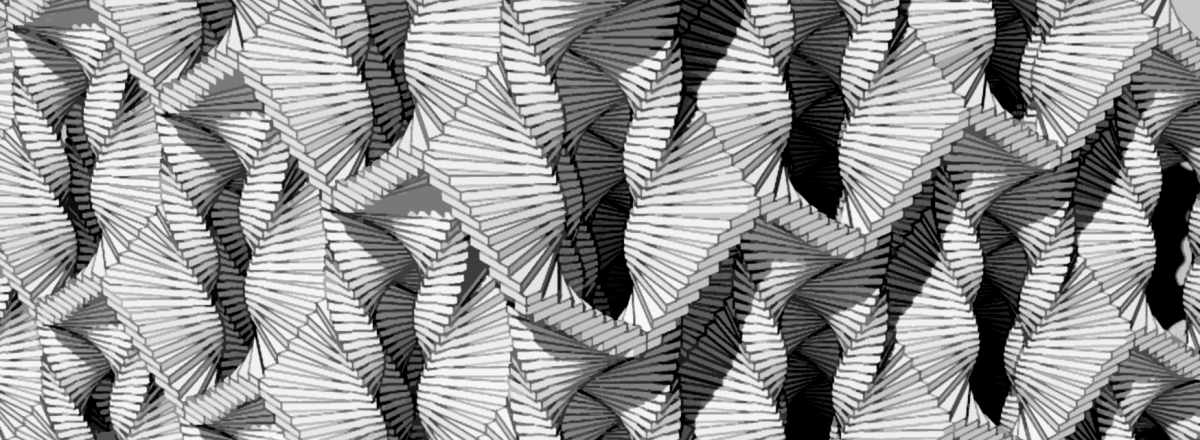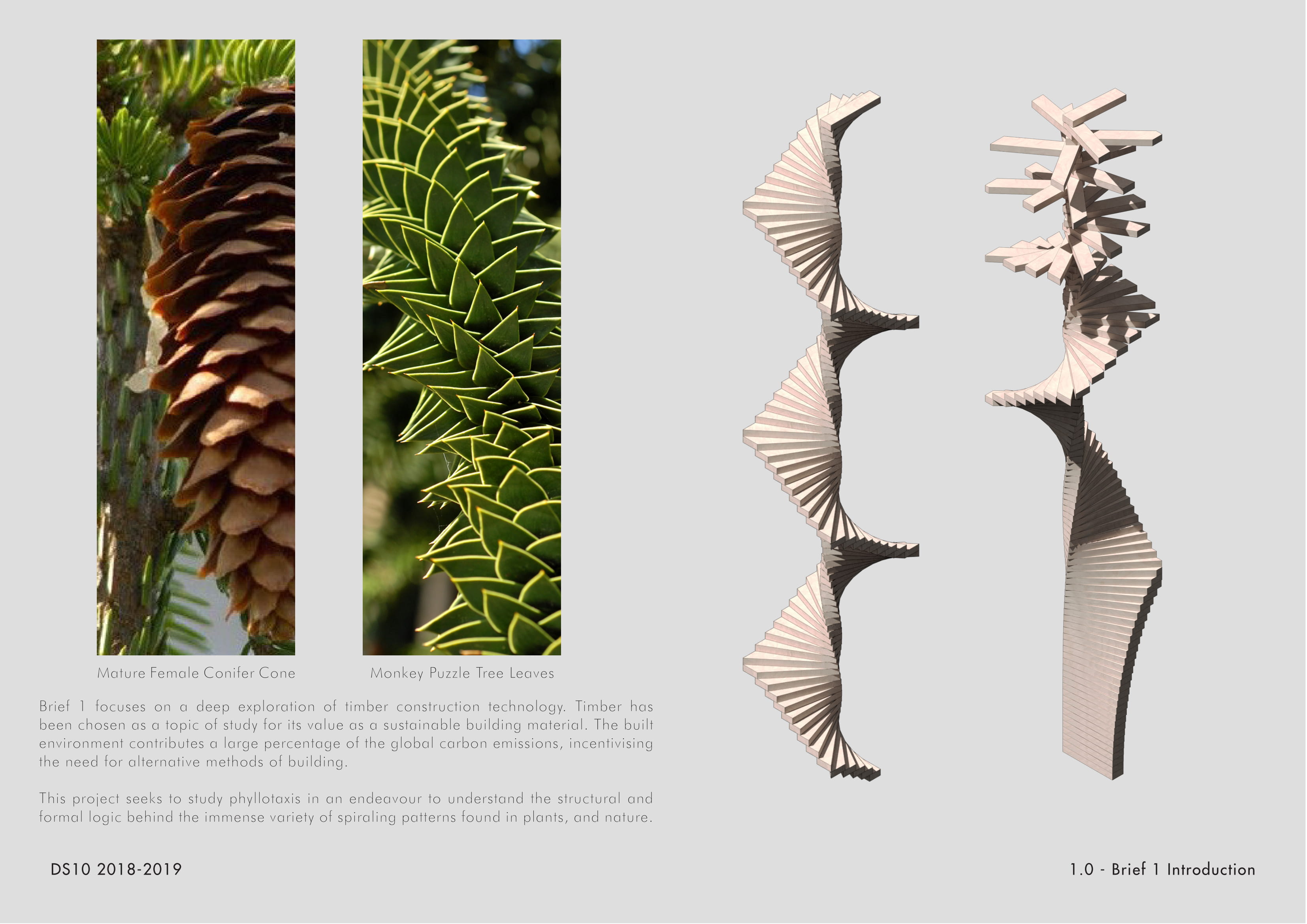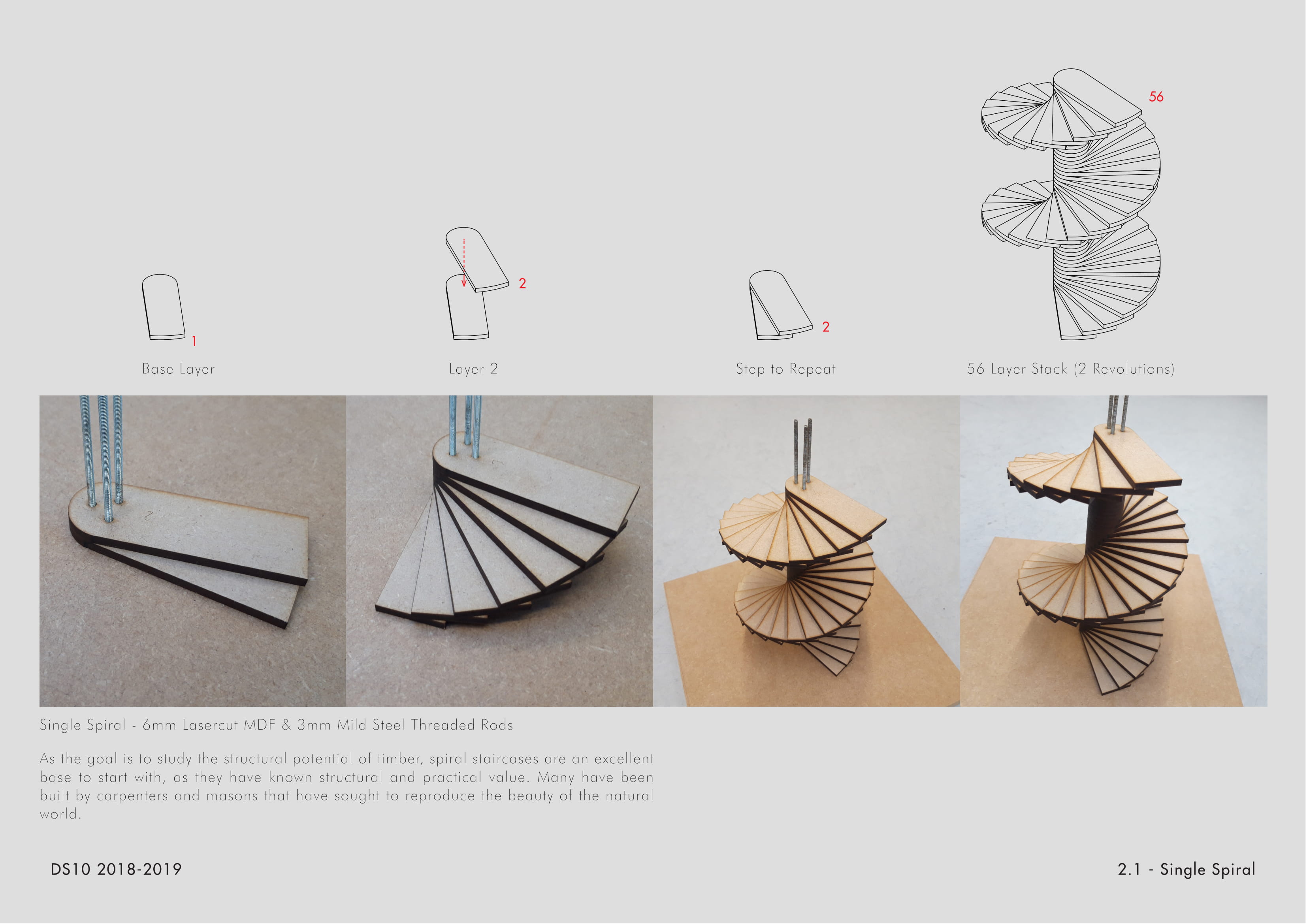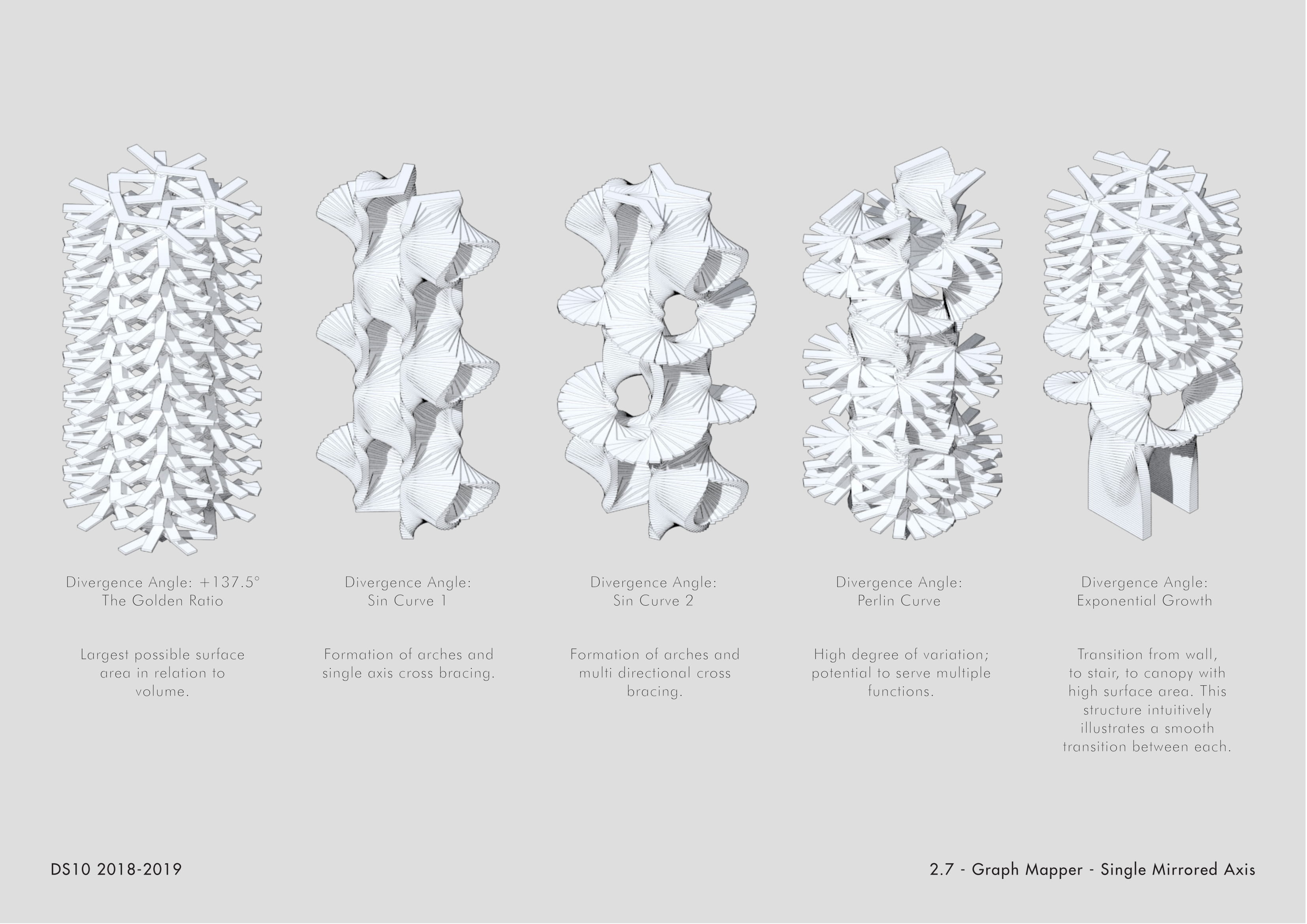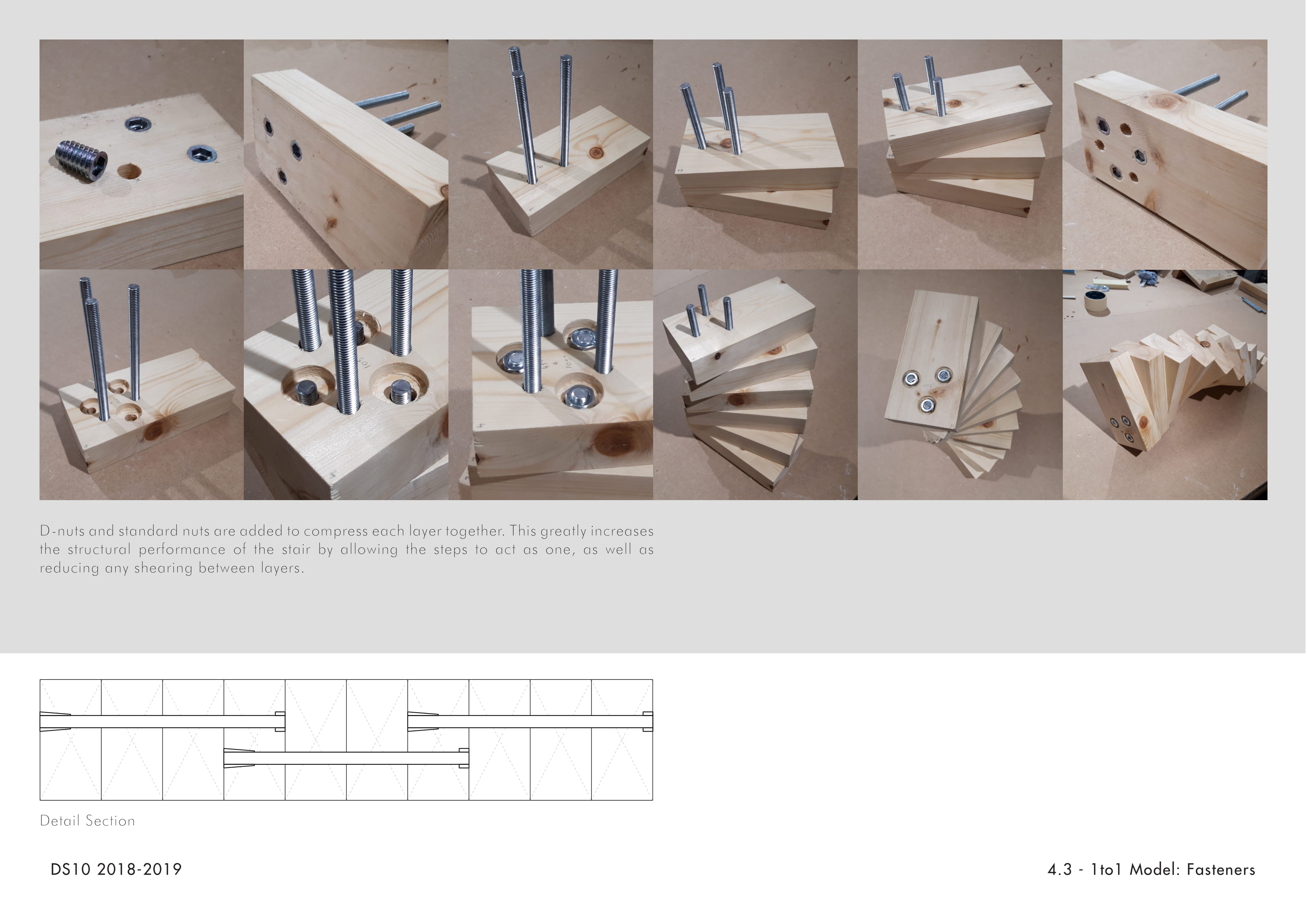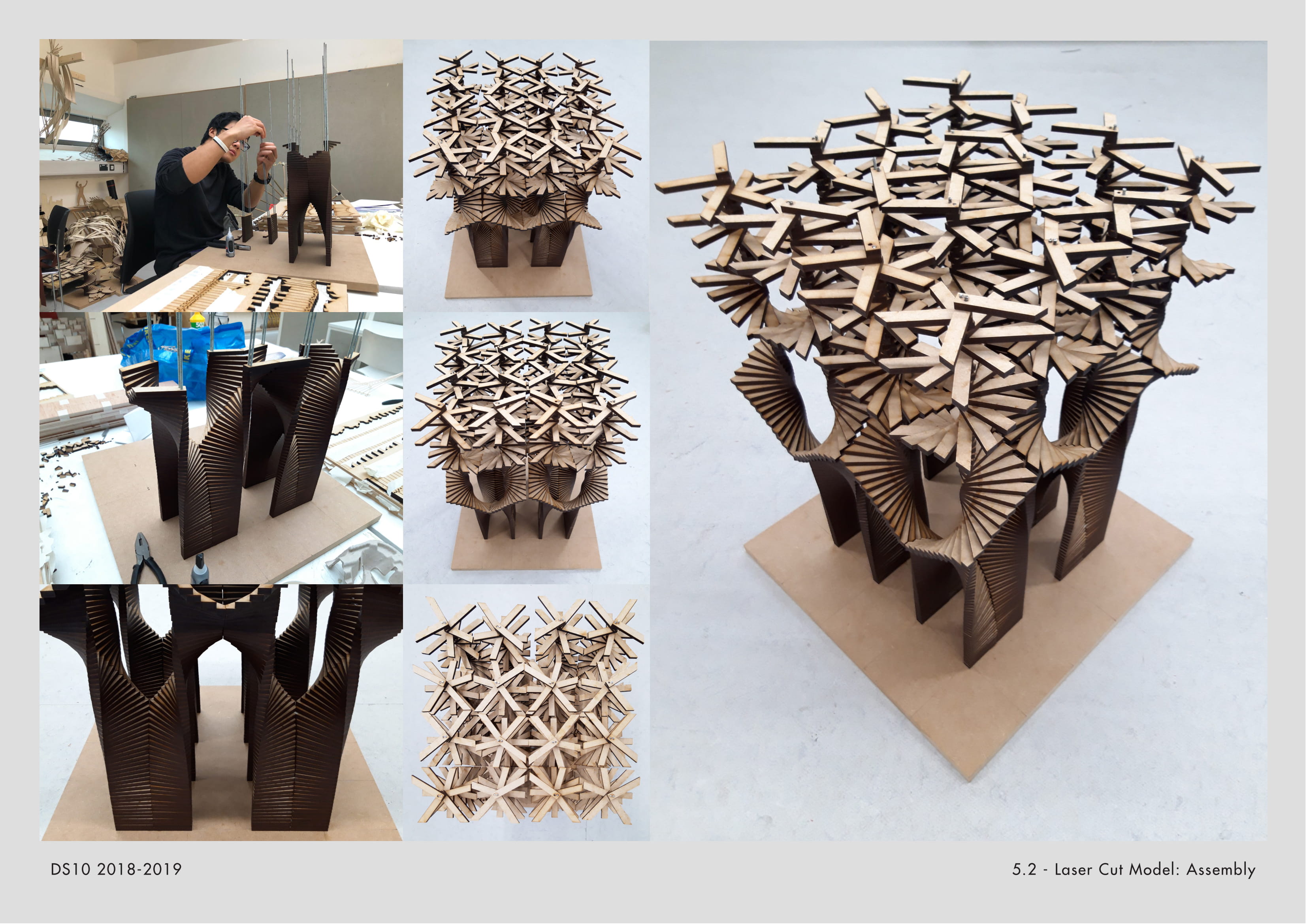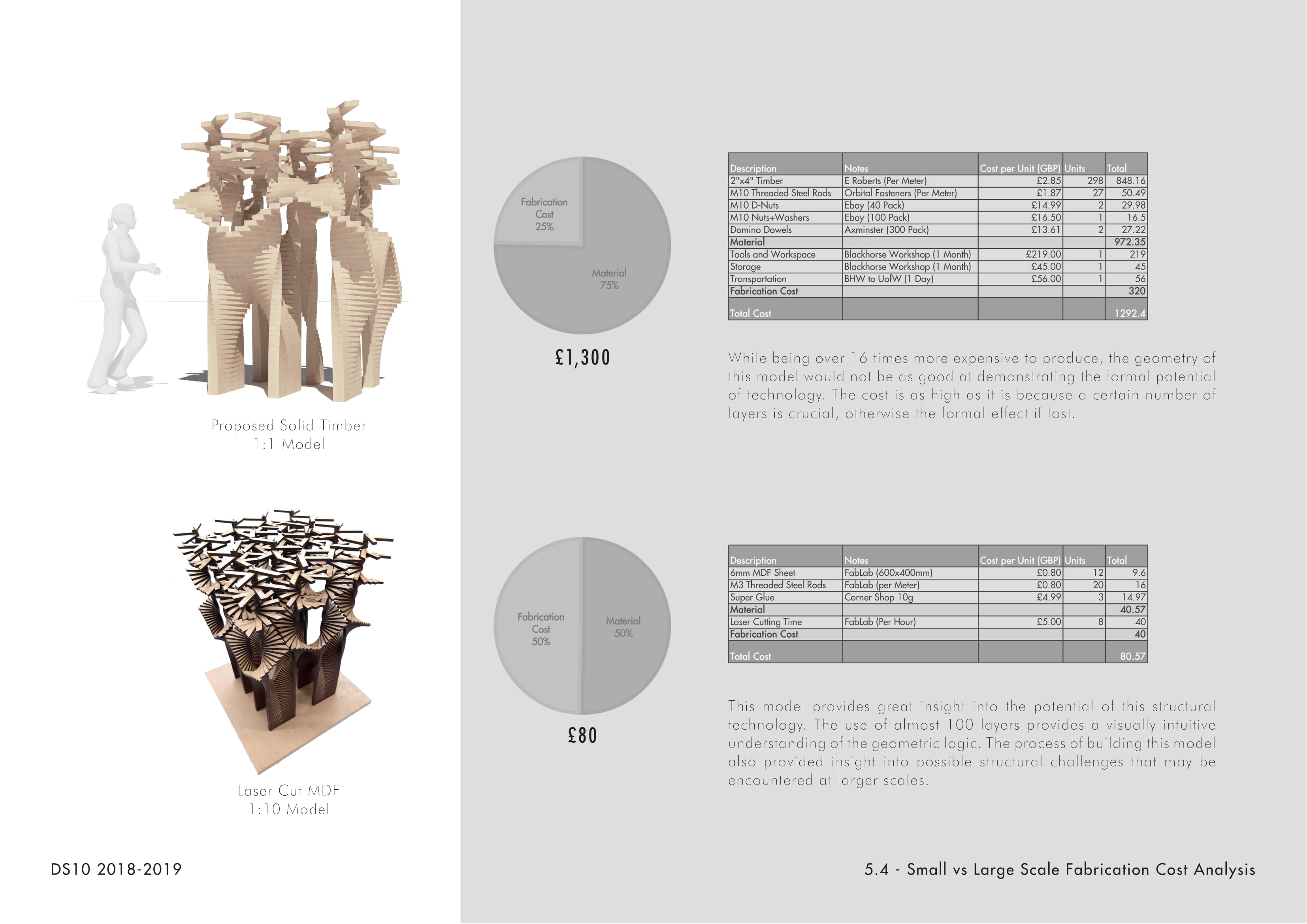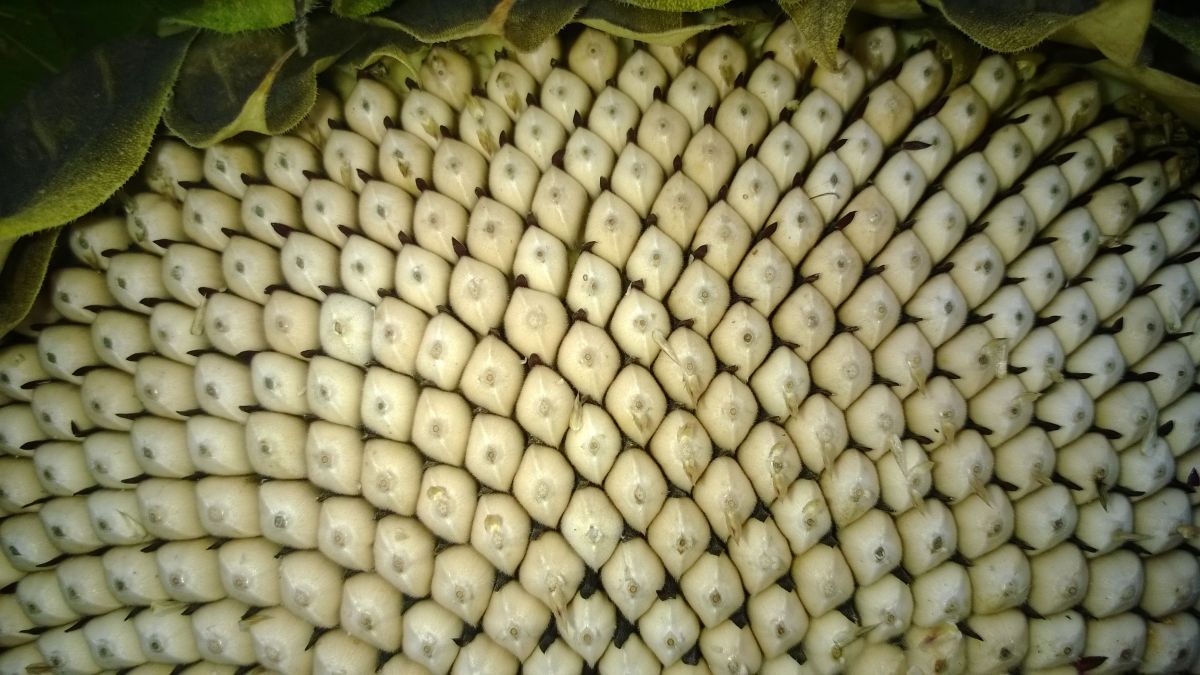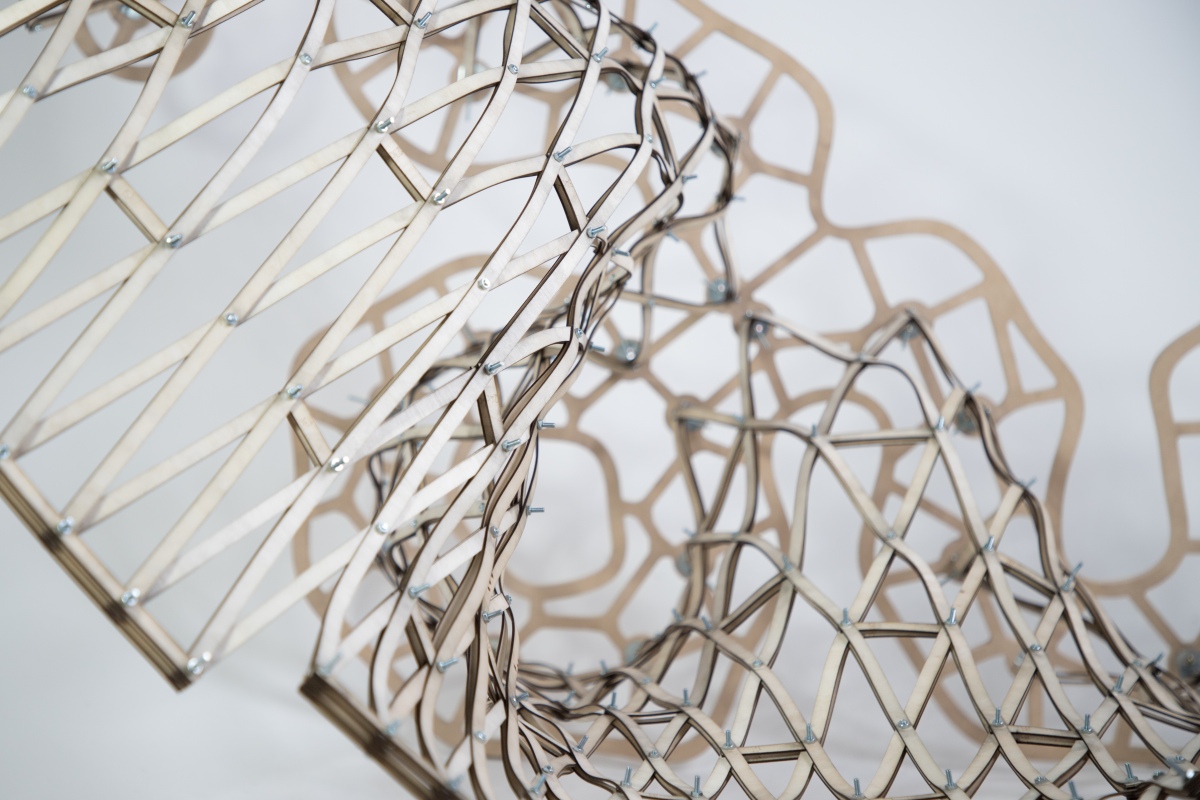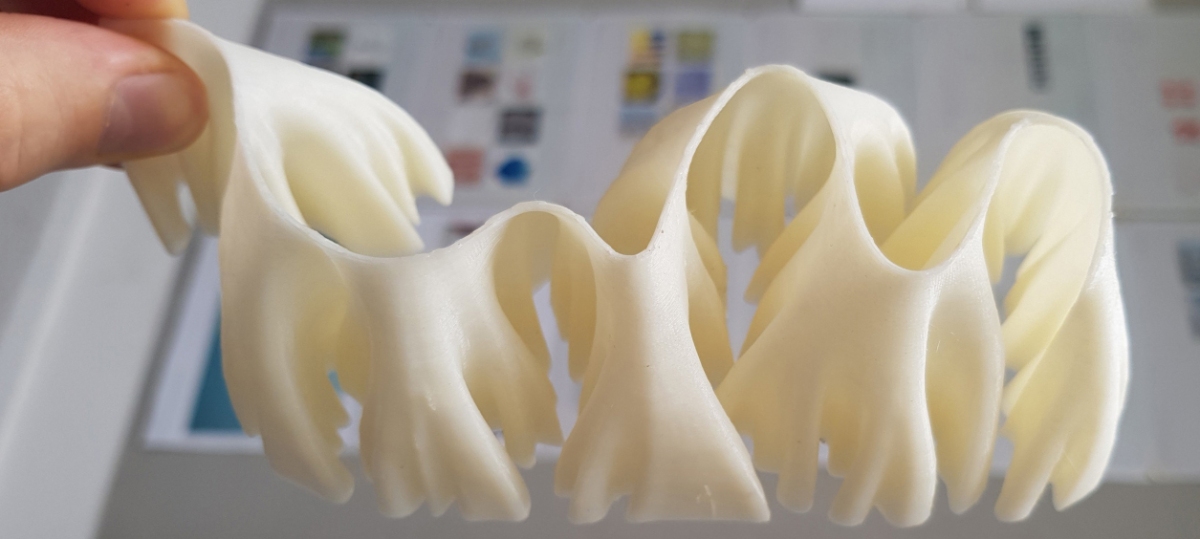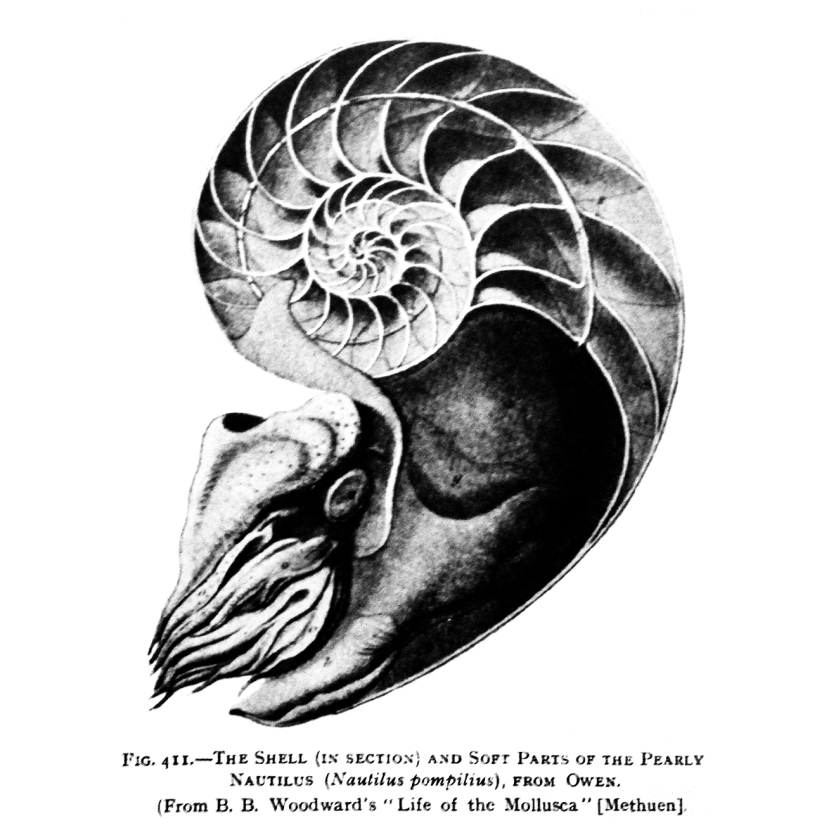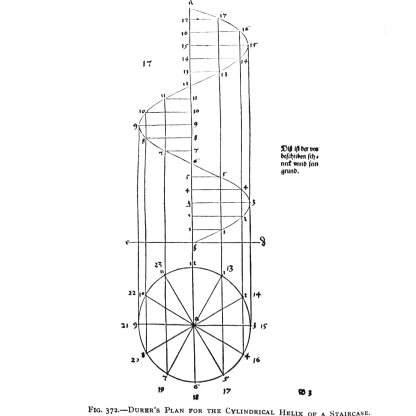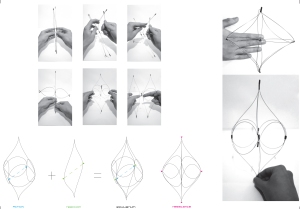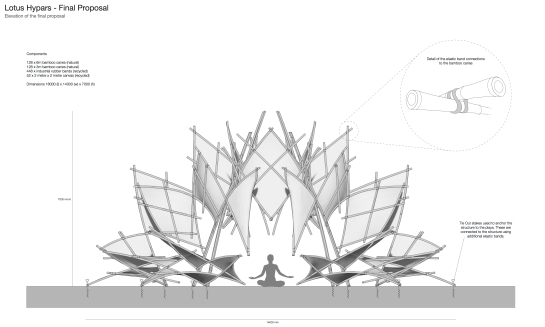Category: Biology
Plants, Math, Spirals, & the Value of the Golden Ratio
The natural world is brimming with ratios, and spirals, that have been captivating mathematicians for centuries.
1.0 Phyllotaxis Spirals
1.1 Rational Numbers
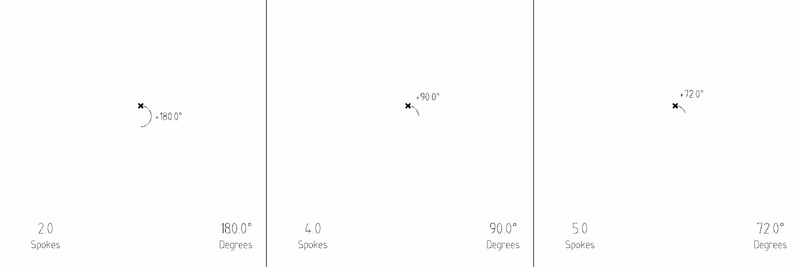
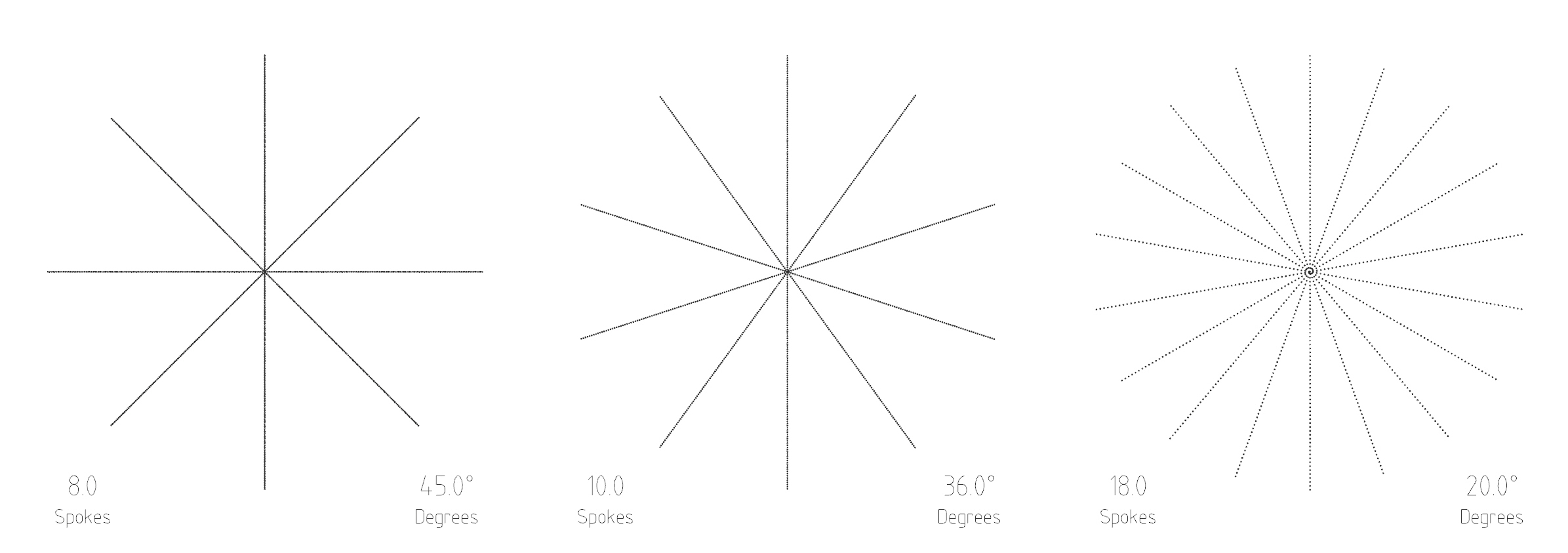
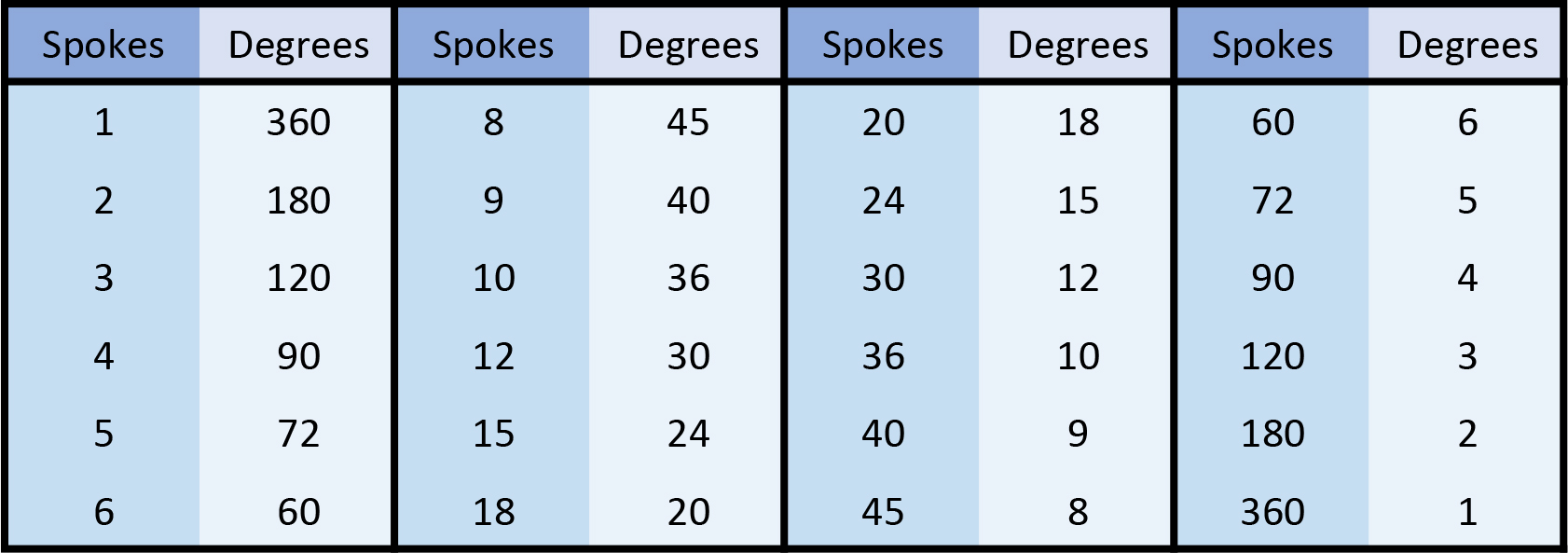
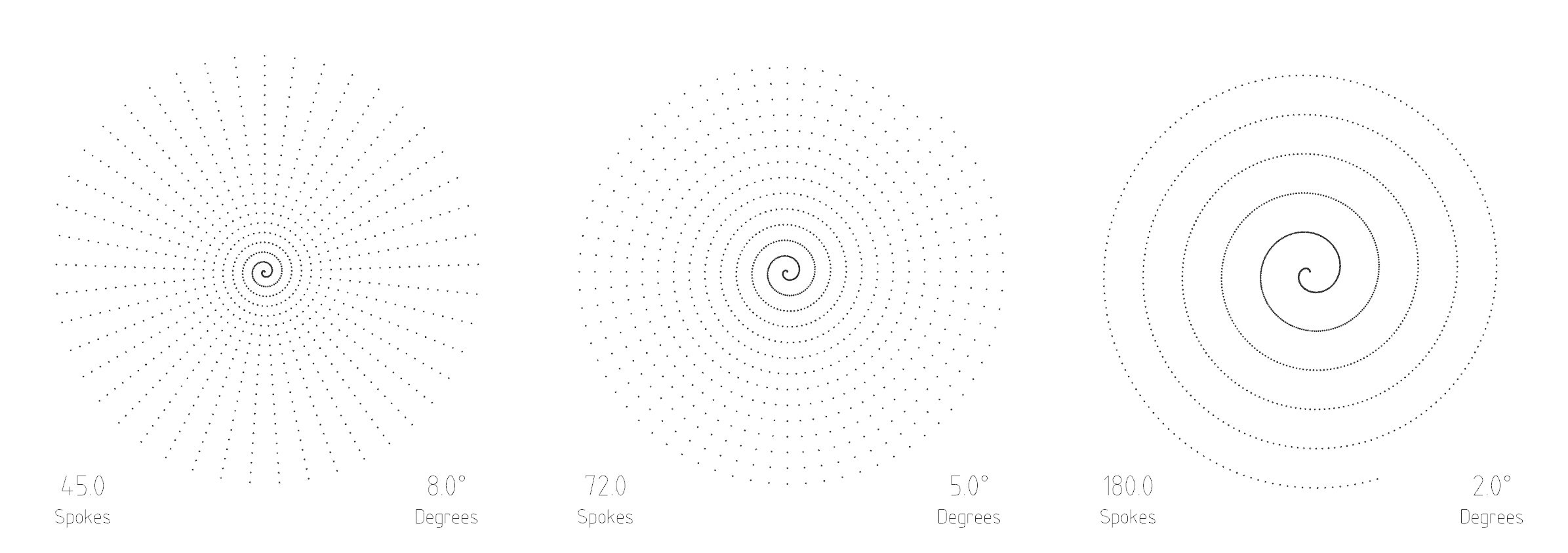
1.2 Irrational Numbers
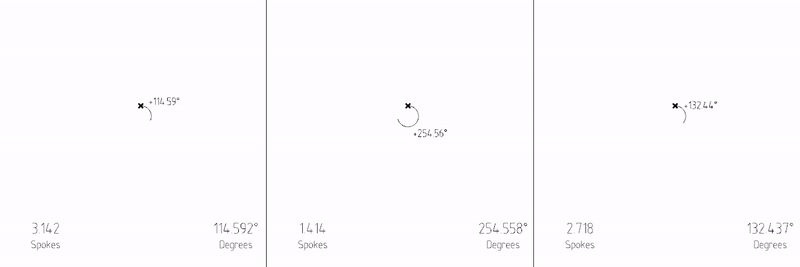
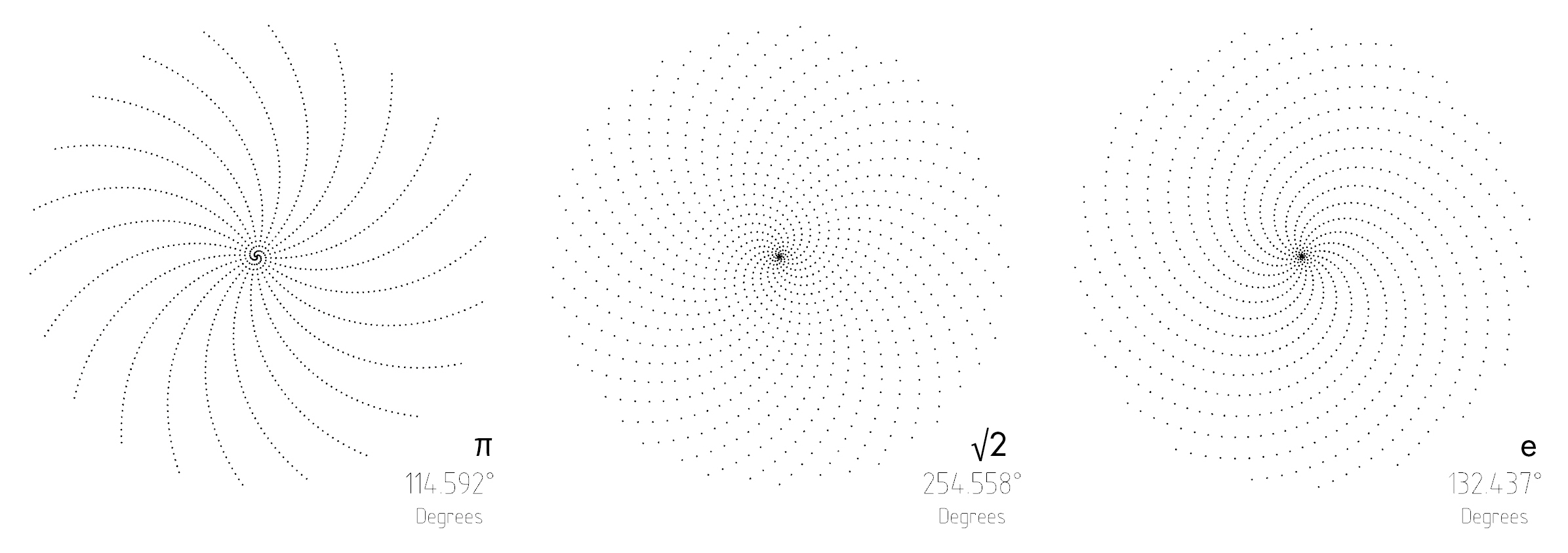
1.3 Quantifiable irrationality
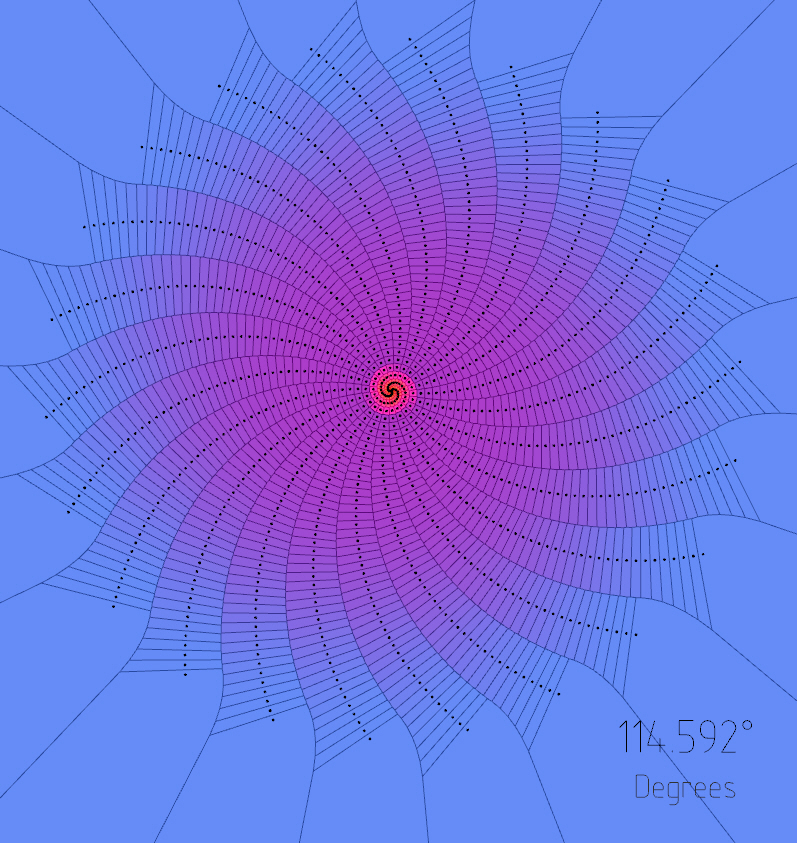

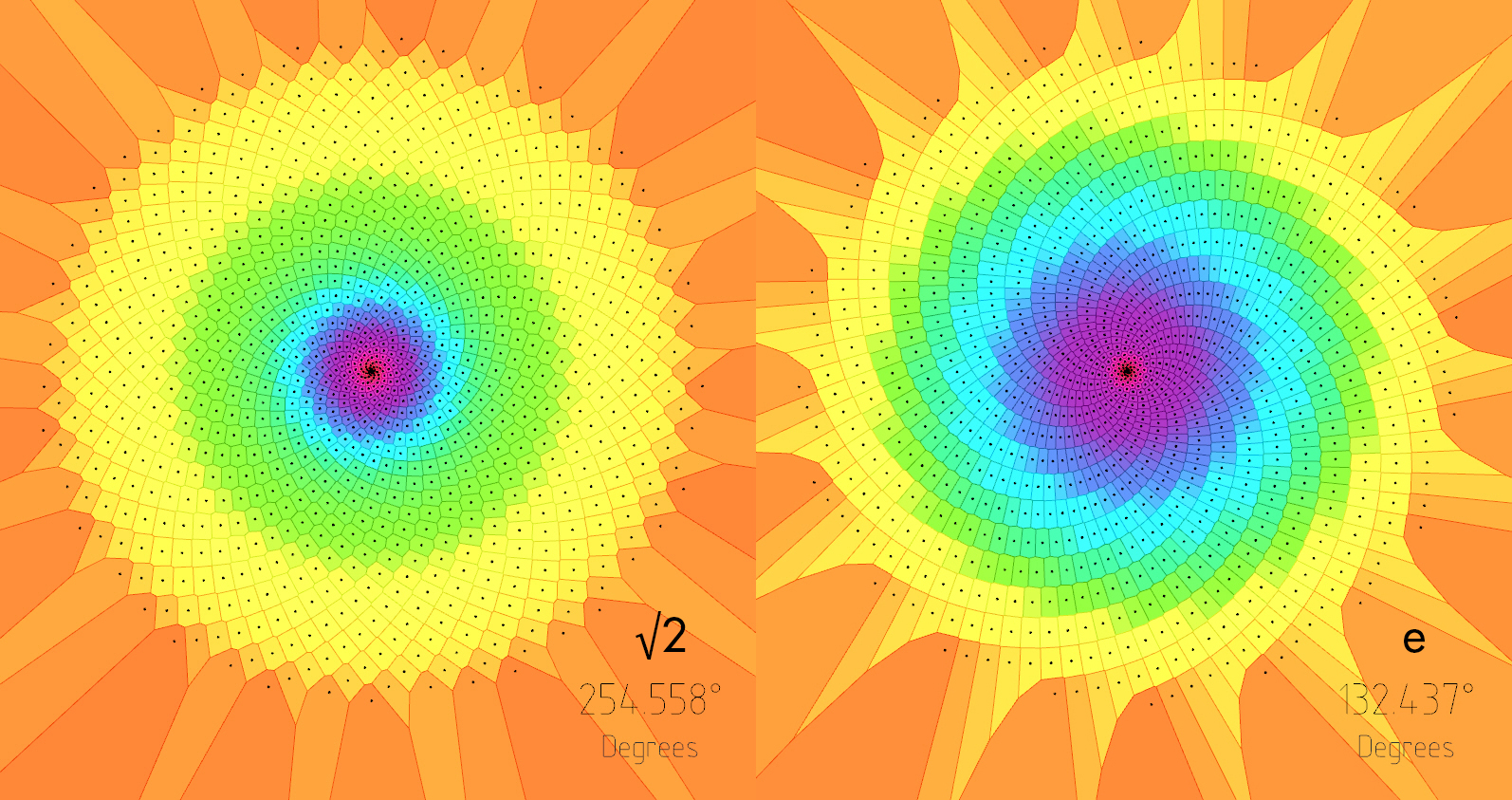
1.4 Phi
Source:
Infinite fractions and the most irrational number: [Link]
The Golden Ratio (why it is so irrational): [Link]

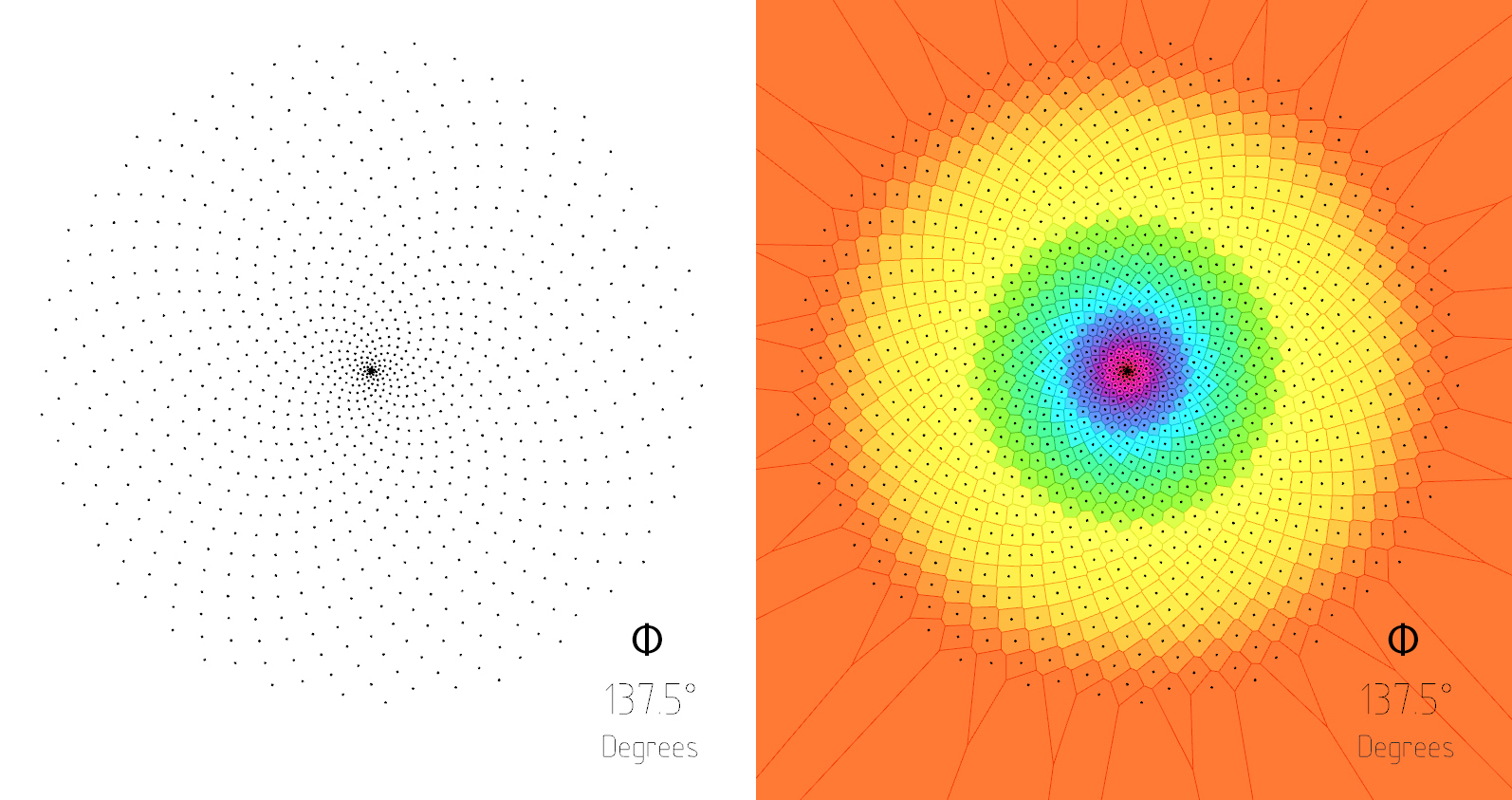
1.5 The Metallic Means & Other Constants
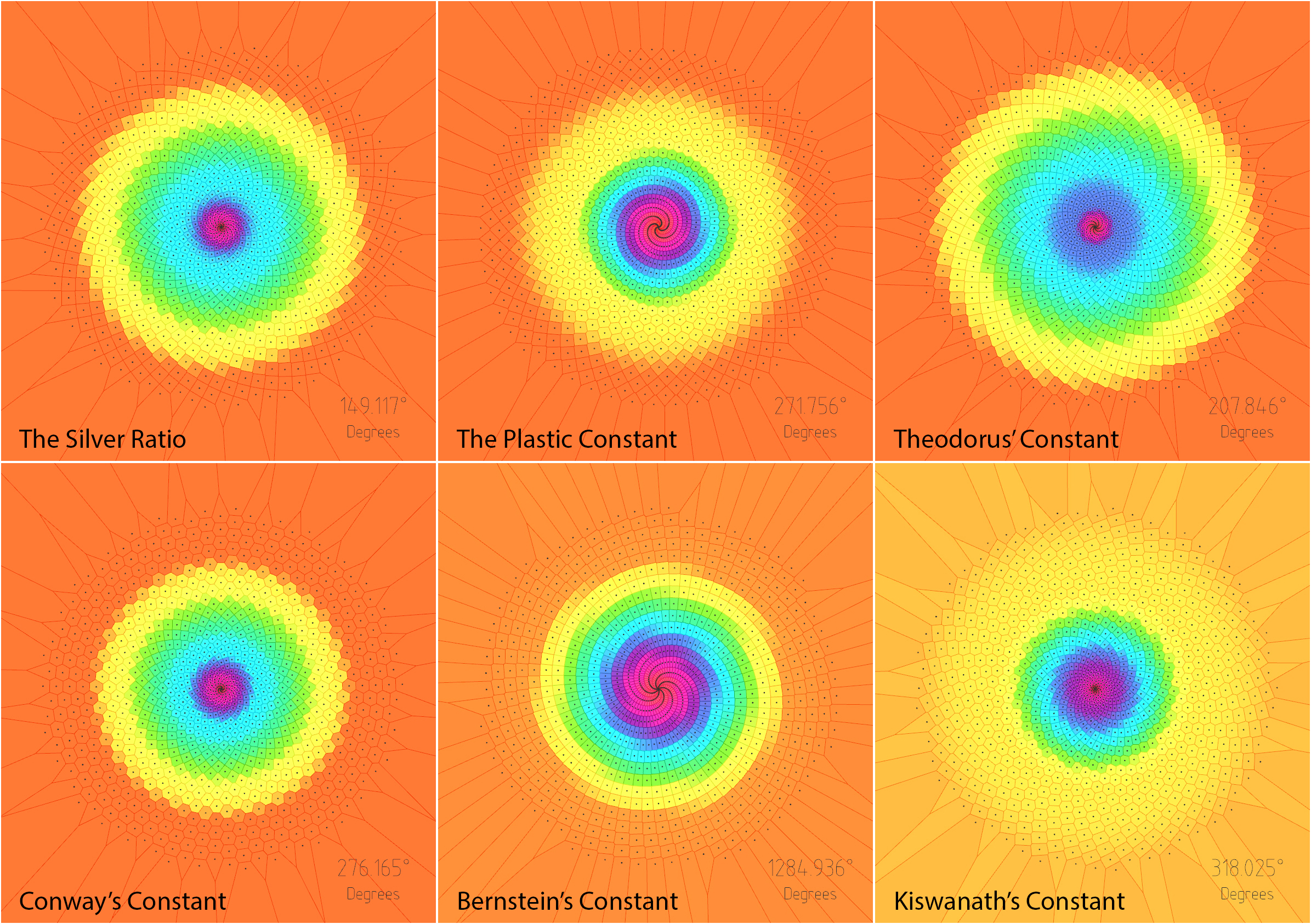
Source:
The Silver Ratio & Metallic Means: [Link]
1.6 Why Spirals?
M.C. Escher said that we adore chaos because we love to produce order. Alain Badiou also said that mathematics is a rigorous aesthetic; it tells us nothing of real being, but forges a fiction of intelligible consistency.
The Nature of Gridshell Form Finding
Grids, shells, and how they, in conjunction with the study of the natural world, can help us develop increasingly complex structural geometry.
Foreword
This post is the third installment of sort of trilogy, after Shapes, Fractals, Time & the Dimensions they Belong to, and Developing Space-Filling Fractals. While it’s not important to have read either of those posts to follow this one, I do think it adds a certain level of depth and continuity.
Regarding my previous entries, it can be difficult to see how any of this has to do with architecture. In fact I know a few people who think studying fractals is pointless.
Admittedly I often struggle to explain to people what fractals are, let alone how they can influence the way buildings look. However, I believe that this post really sheds light on how these kinds of studies may directly influence and enhance our understanding (and perhaps even the future) of our built environment.
On a separate note, I heard that a member of the architectural academia said “forget biomimicry, it doesn’t work.”
Firstly, I’m pretty sure Frei Otto would be rolling over in his grave.
Secondly, if someone thinks that biomimicry is useless, it’s because they don’t really understand what biomimicry is. And I think the same can be said regarding the study of fractals. They are closely related fields of study, and I wholeheartedly believe they are fertile grounds for architectural marvels to come.
7.0 Introduction to Shells
As far as classification goes, shells generally fall under the category of two-dimensional shapes. They are defined by a curved surface, where the material is thin in the direction perpendicular to the surface. However, assigning a dimension to certain shells can be tricky, since it kinda depends on how zoomed in you are.
A strainer is a good example of this – a two-dimensional gridshell. But if you zoom in, it is comprised of a series of woven, one-dimensional wires. And if you zoom in even further, you see that each wire is of course comprised of a certain volume of metal.
This is a property shared with many fractals, where their dimension can appear different depending on the level of magnification. And while there’s an infinite variety of possible shells, they are (for the most part) categorizable.
7.1 – Single Curved Surfaces
Analytic geometry is created in relation to Cartesian planes, using mathematical equations and a coordinate systems. Synthetic geometry is essentially free-form geometry (that isn’t defined by coordinates or equations), with the use of a variety of curves called splines. The following shapes were created via Synthetic geometry, where we’re calling our splines ‘u’ and ‘v.’
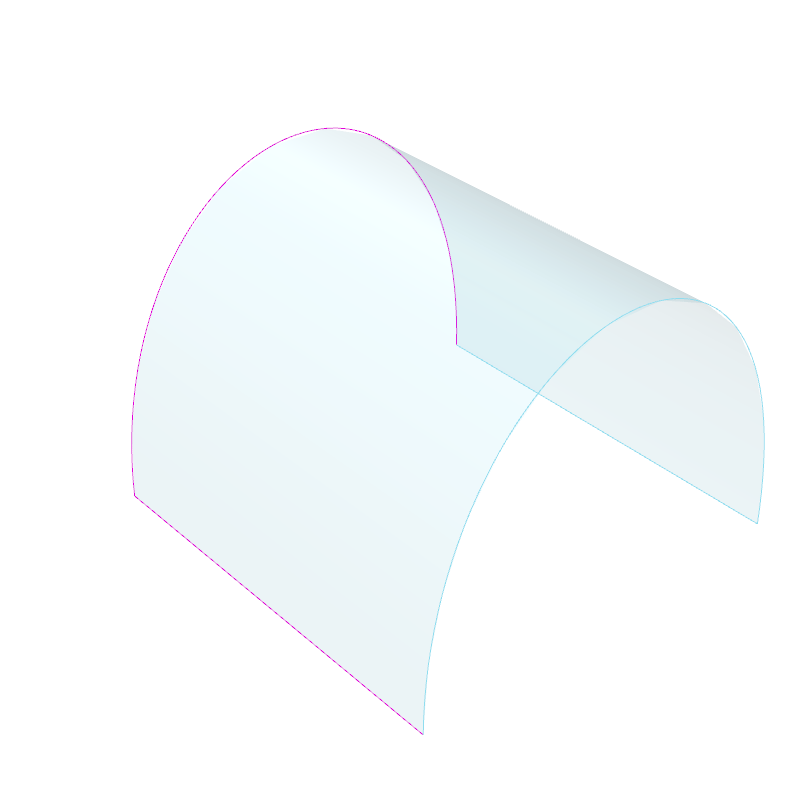
These curves highlight each dimension of the two-dimensional surface. In this case only one of the two ‘curves’ is actually curved, making this shape developable. This means that if, for example, it was made of paper, you could flatten it completely.
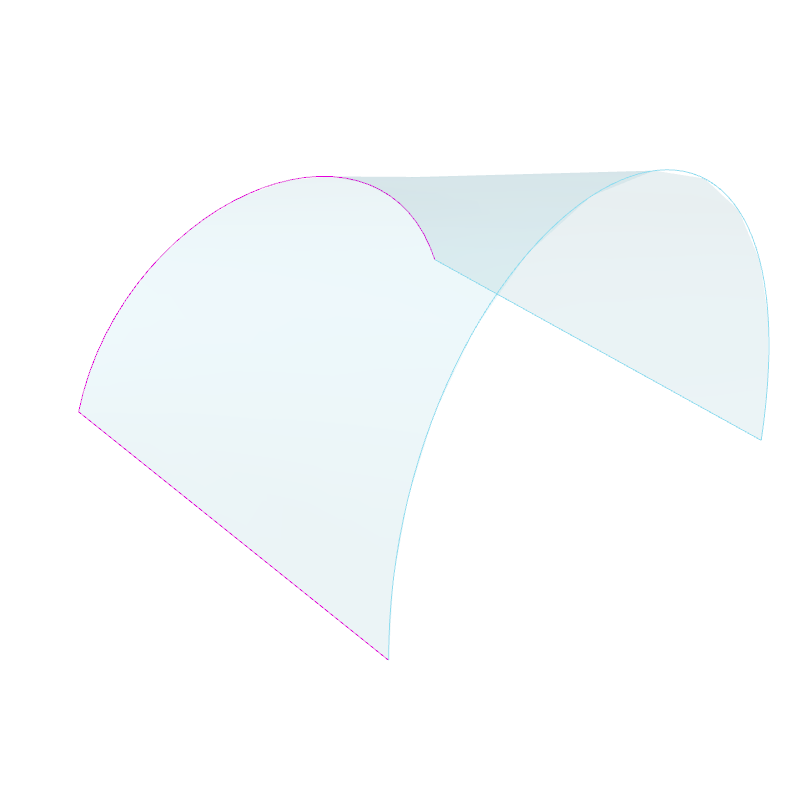
Uniclastic: Conoid (Conical paraboloid)
In this case, one of them grows in length, but the other still remains straight. Since one of the dimensions remains straight, it’s still a single curved surface – capable of being flattened without changing the area. Singly curved surfaced may also be referred to as uniclastic or monoclastic.
7.2 – Double Curved Surfaces
These can be classified as synclastic or anticlastic, and are non-developable surfaces. If made of paper, you could not flatten them without tearing, folding or crumpling them.
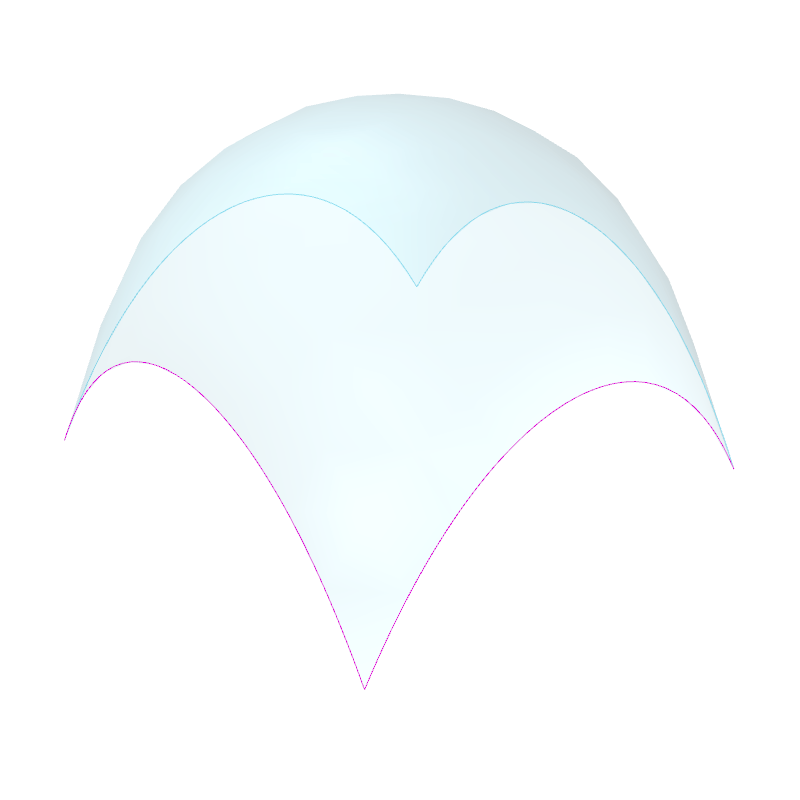
In this case, both curves happen to be identical, but what’s important is that both dimensions are curving in the same direction. In this orientation, the dome is also under compression everywhere.
The surface of the earth is double curved, synclastic – non-developable. “The surface of a sphere cannot be represented on a plane without distortion,” a topic explored by Michael Stevens: https://www.youtube.com/watch?v=2lR7s1Y6Zig
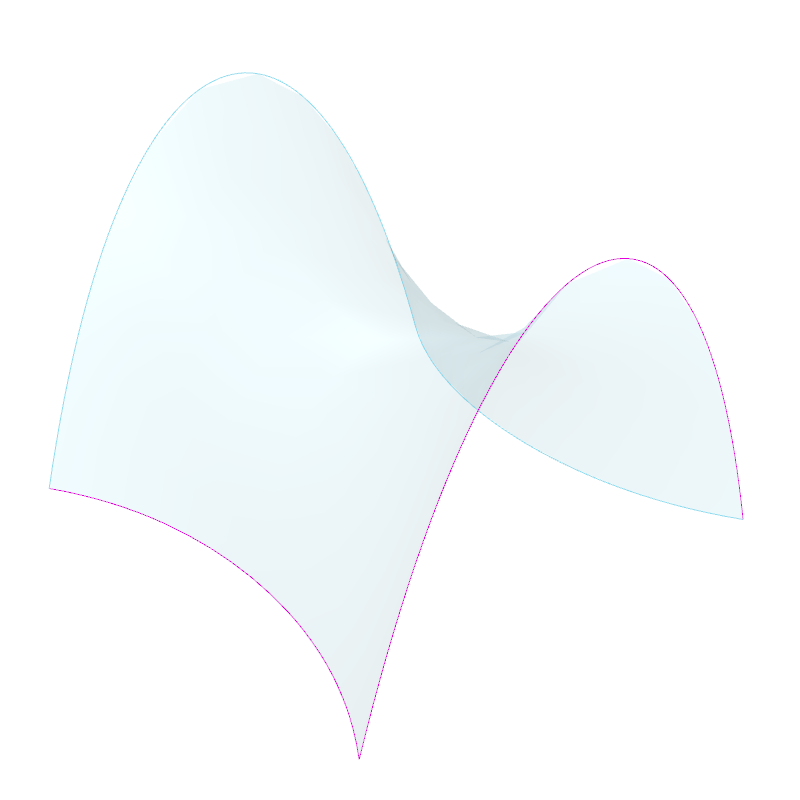
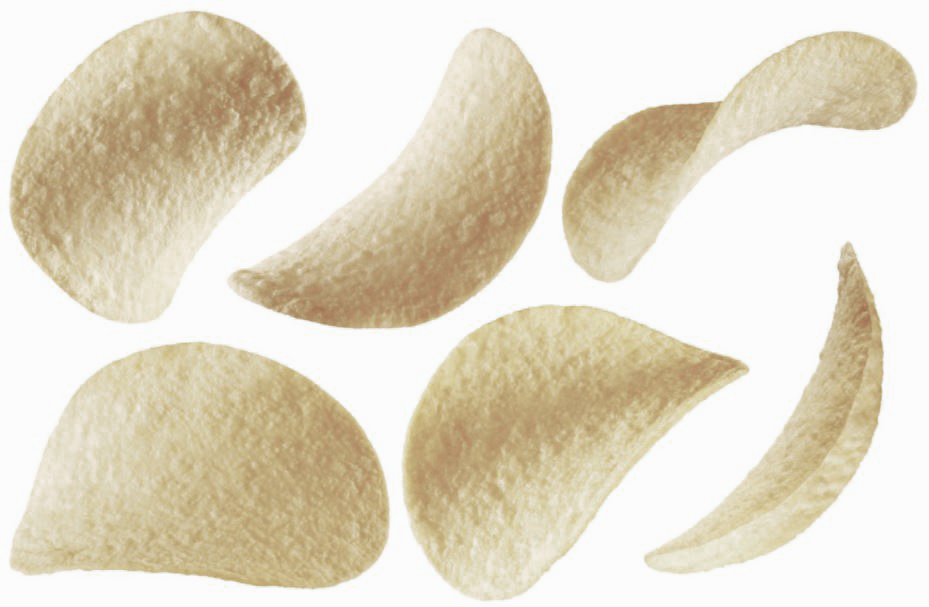
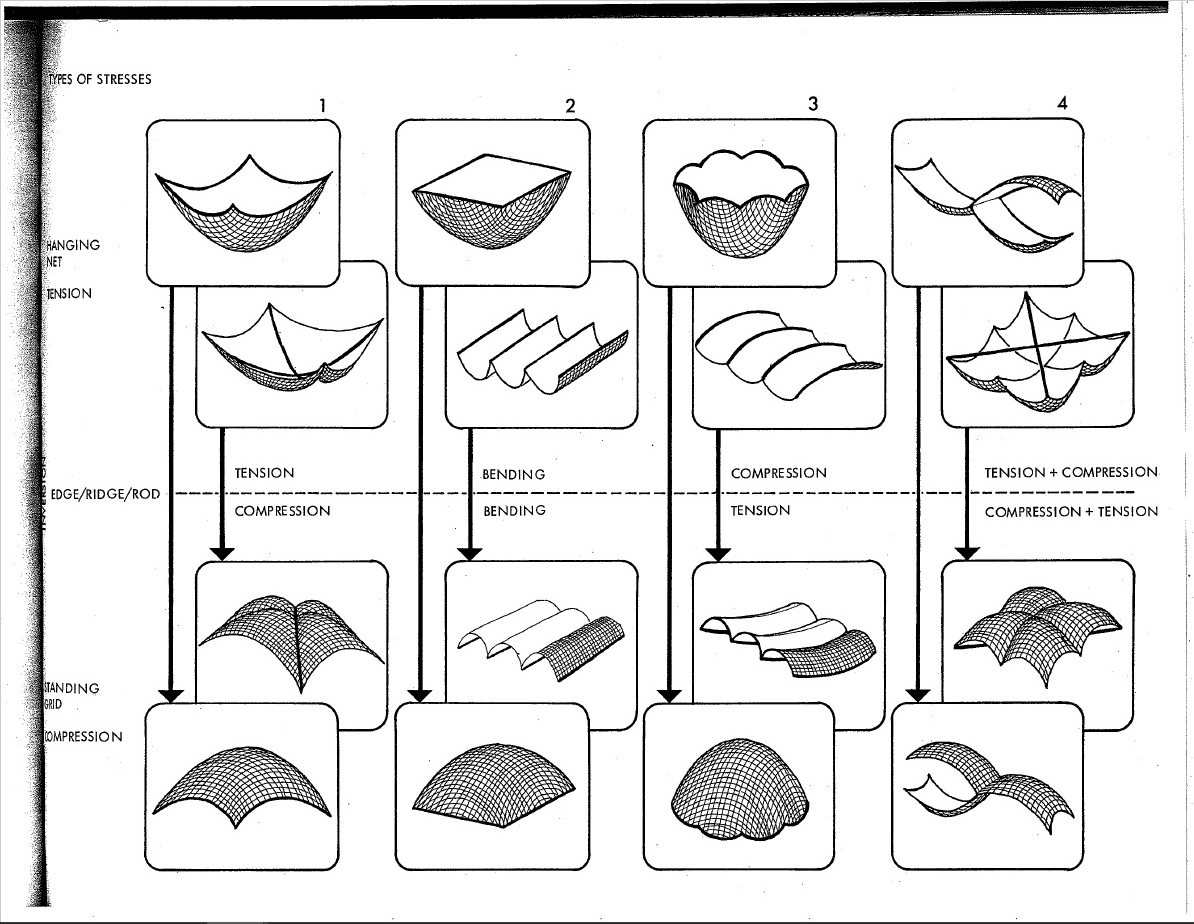
7.3 – Translation vs Revolution
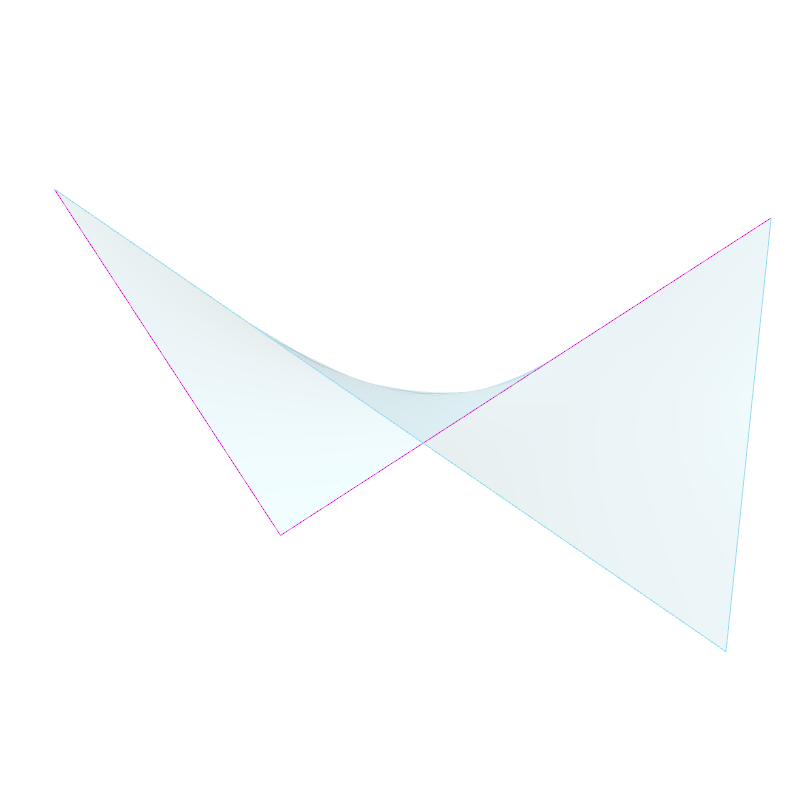
This shape was achieved by sweeping a straight line over a straight path at one end, and another straight path at the other. This will work as long as both rails are not parallel. Although I find this shape perplexing; it’s double curvature that you can create with straight lines, yet non-developable, and I can’t explain it..
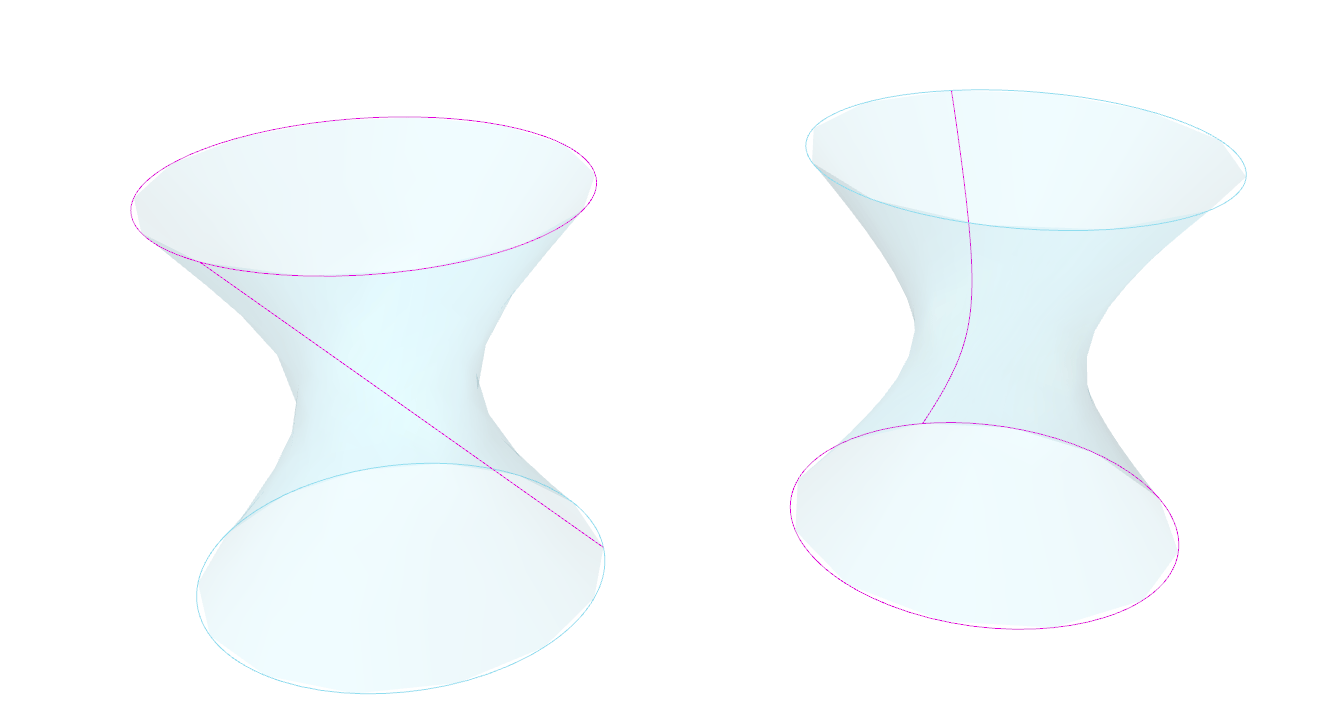
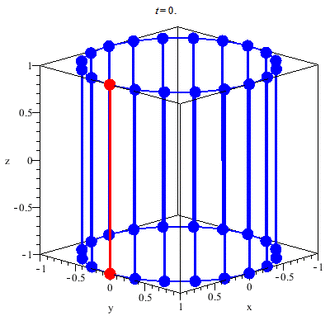
The hyperboloid has been a popular design choice for (especially nuclear cooling) towers. It has excellent tensile and compressive properties, and can be built with straight members. This makes it relatively cheap and easy to fabricate relative to it’s size and performance.
8.0 Geodesic Curves
These are singly curved curves, although that does sound confusing. A simple way to understand what geodesic curves are, is to give them a width. As previously explored, we know that curves can inhabit, and fill, two-dimensional space. However, you can’t really observe the twists and turns of a shape that has no thickness.
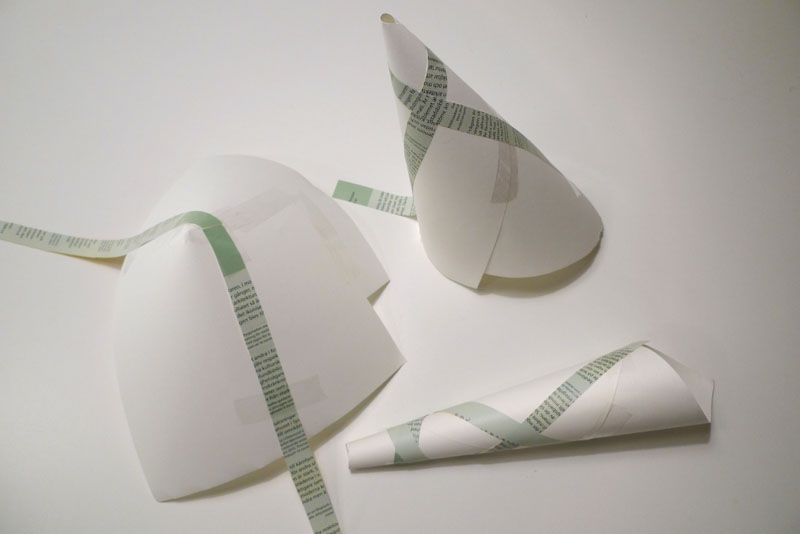
A ribbon is essentially a straight line with thickness, and when used to follow the curvature of a surface (as seen above), the result is a plank line. The term ‘plank line’ can be defined as a line with an given width (like a plank of wood) that passes over a surface and does not curve in the tangential plane, and whose width is always tangential to the surface.
Since one-dimensional curves do have an orientation in digital modeling, geodesic curves can be described as the one-dimensional counterpart to plank lines, and can benefit from the same definition.
The University of Southern California published a paper exploring the topic further: http://papers.cumincad.org/data/works/att/f197.content.pdf
8.1 – Basic Grid Setup
For simplicity, here’s a basic grid set up on a flat plane:
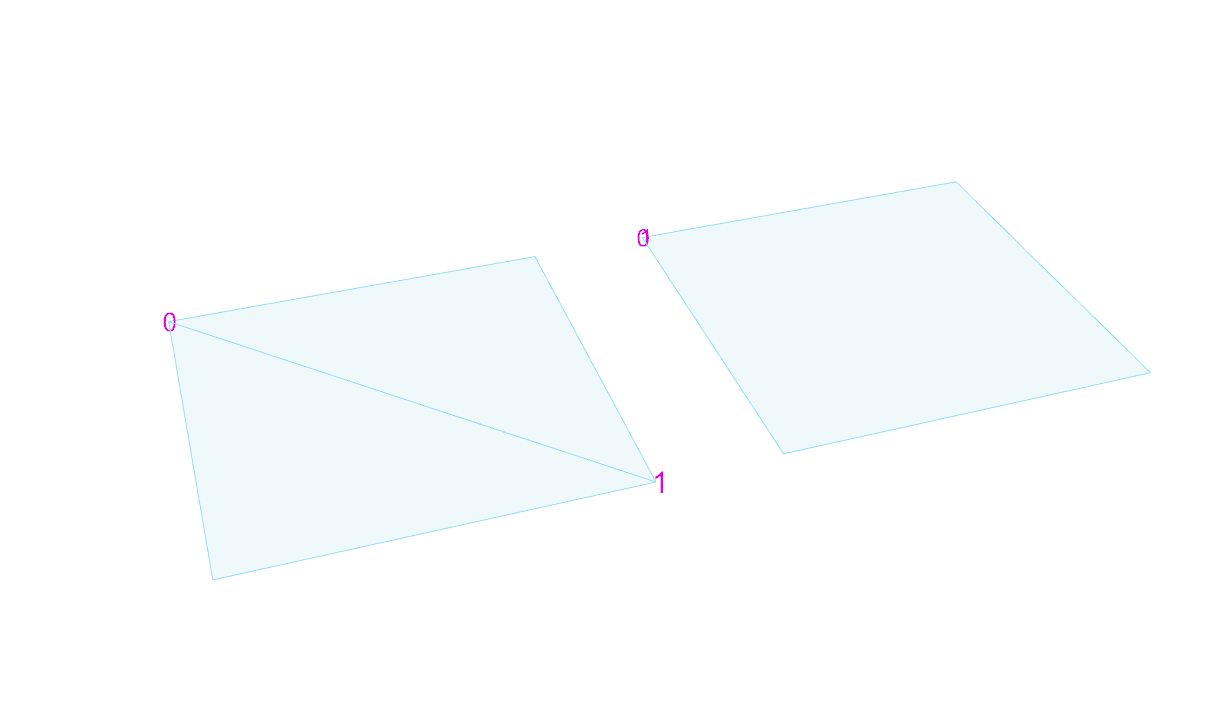
We start by defining two points anywhere along the edge of the surface. Then we find the geodesic curve that joins the pair. Of course it’s trivial in this case, since we’re dealing with a flat surface, but bear with me.
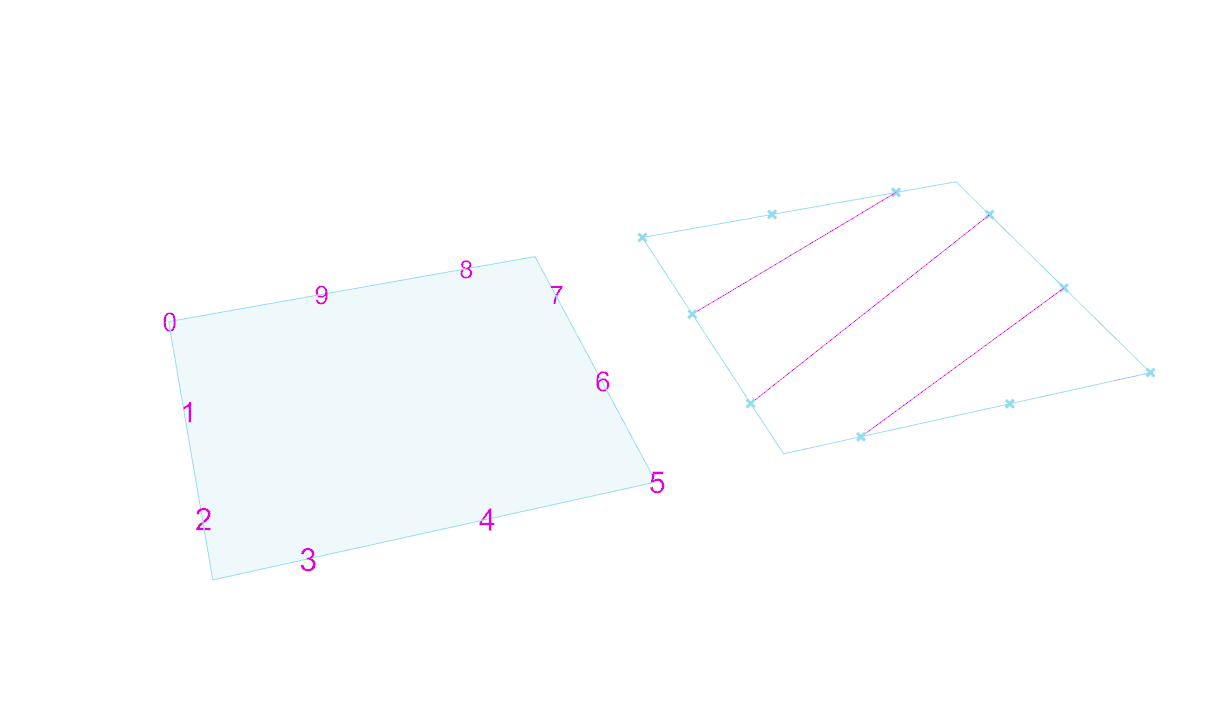
We can keep adding pairs of points along the edge. In this case they’re kept evenly spaced and uncrossing for the sake of a cleaner grid.
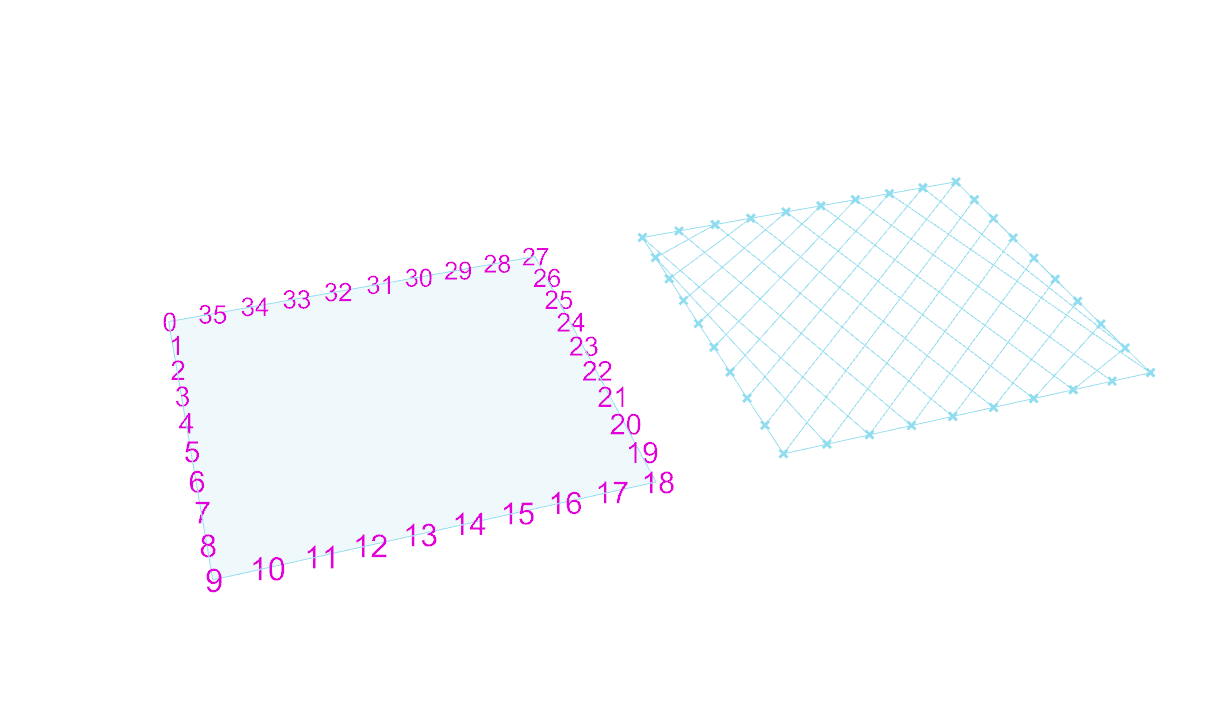
After that, it’s simply a matter of playing with density, as well as adding an additional set of antagonistic curves. For practicality, each set share the same set of base points.
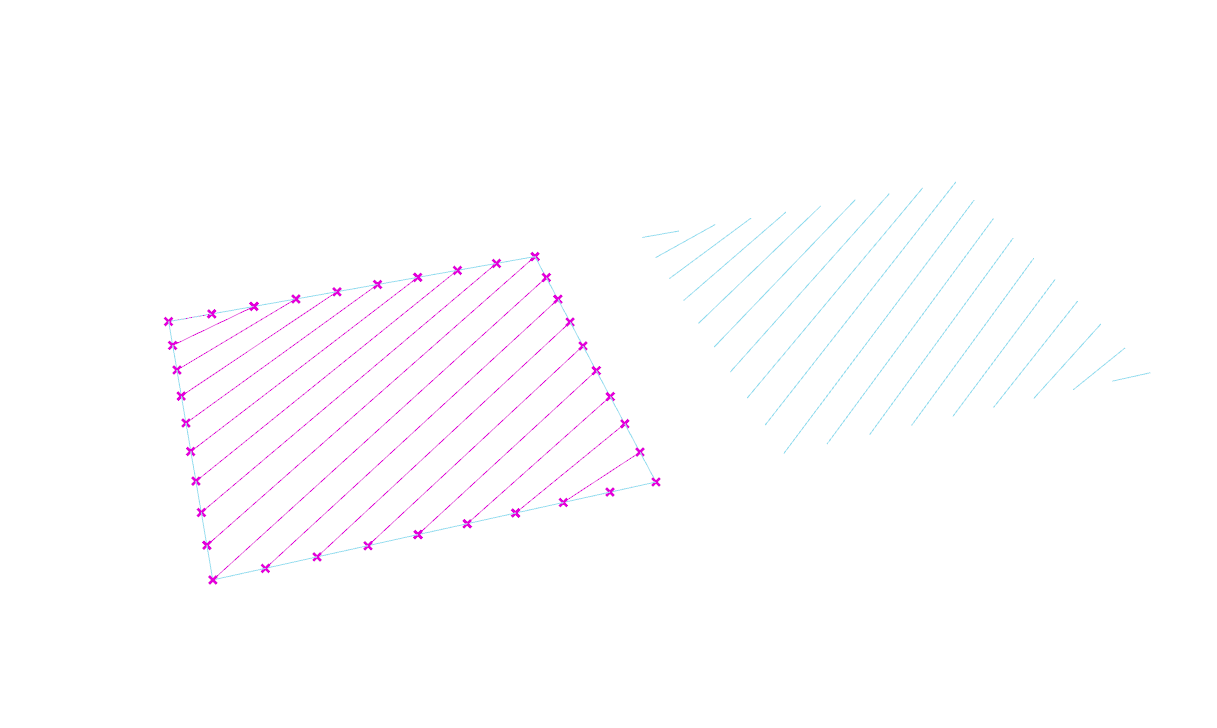
He’s an example of a grid where each set has their own set of anchors. While this does show the flexibility of a grid, I think it’s far more advantageous for them to share the same base points.
8.2 – Basic Gridshells
The same principle is then applied to a series of surfaces with varied types of curvature.
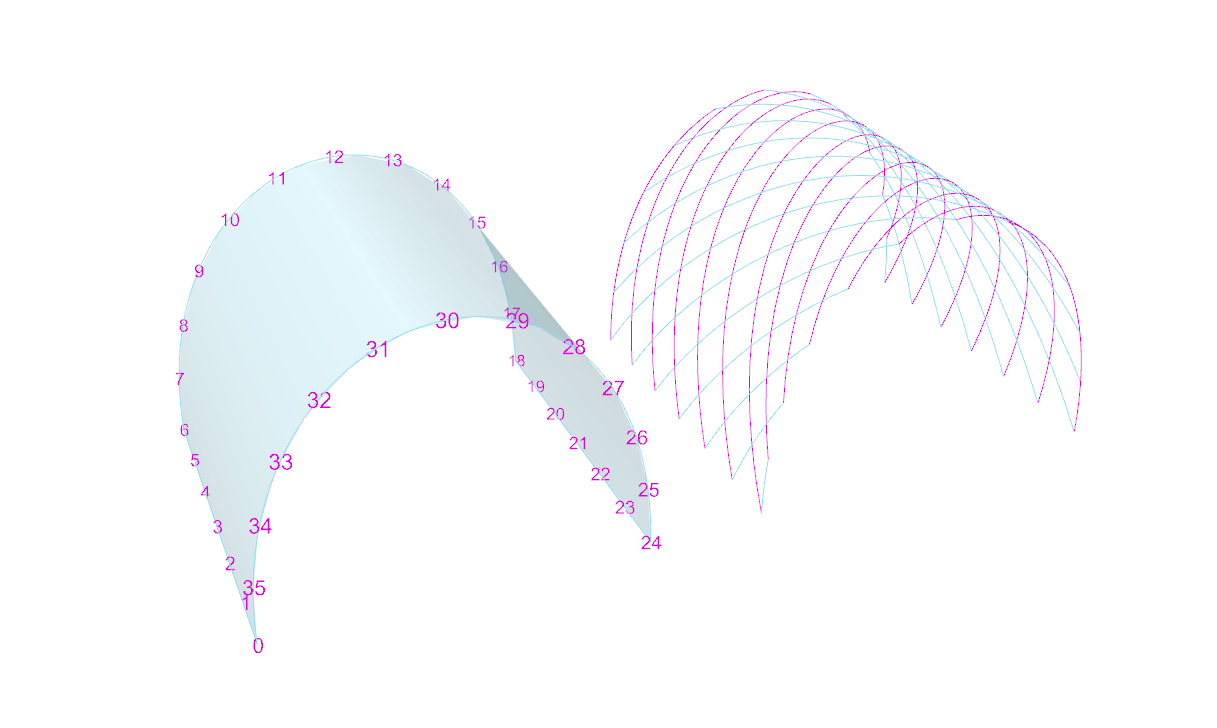
First comes the shell (a barrel vault in this case), then comes the grid. The symmetrical nature of this surface translates to a pretty regular (and also symmetrical) gridshell. The use of geodesic curves means that these gridshells can be fabricated using completely straight material, that only necessitate single curvature.
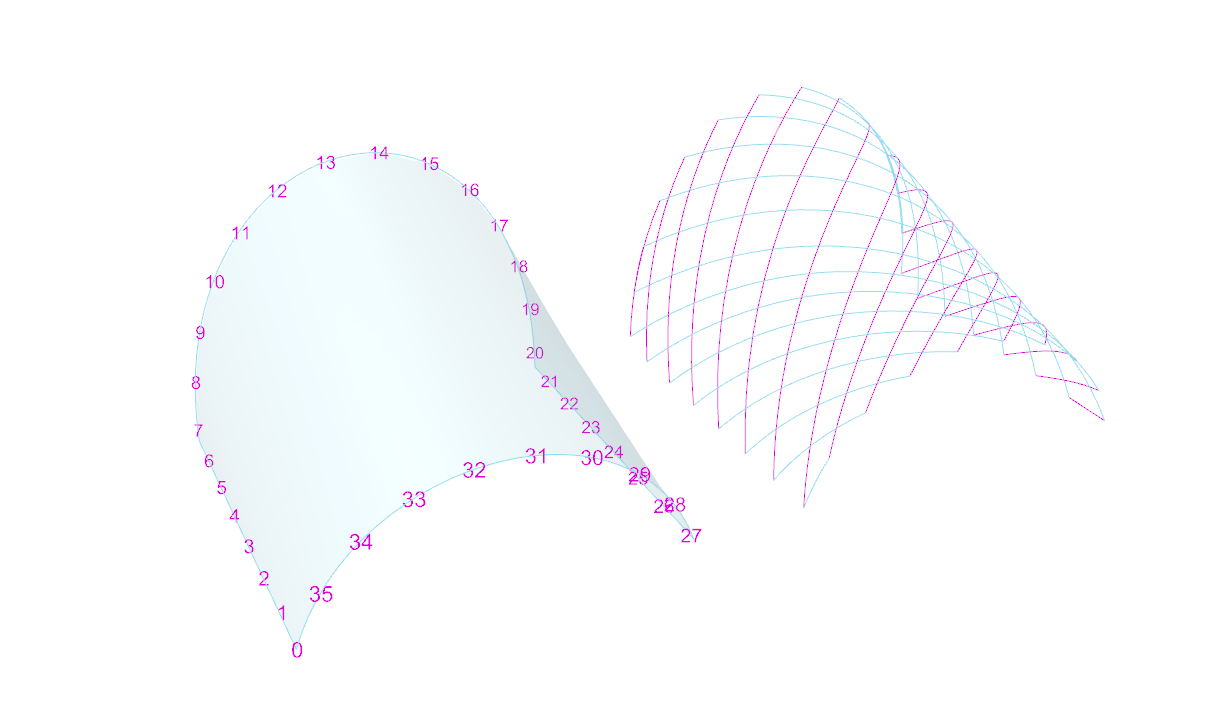
The same grid used on a conical surface starts to reveal gradual shifts in the geometry’s spacing. The curves always search for the path of least resistance in terms of bending.
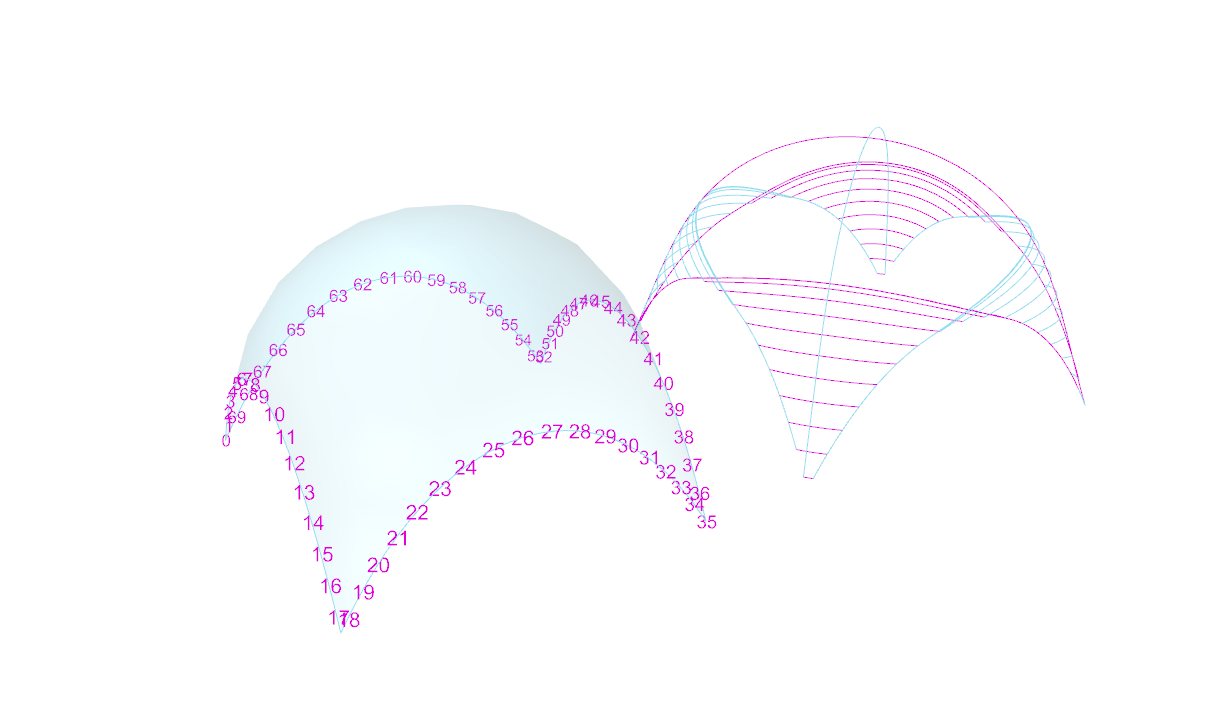
This case illustrates the nature of geodesic curves quite well. The dome was free-formed with a relatively high degree of curvature. A small change in the location of each anchor point translates to a large change in curvature between them. Each curve looks for the shortest path between each pair (without leaving the surface), but only has access to single curvature.
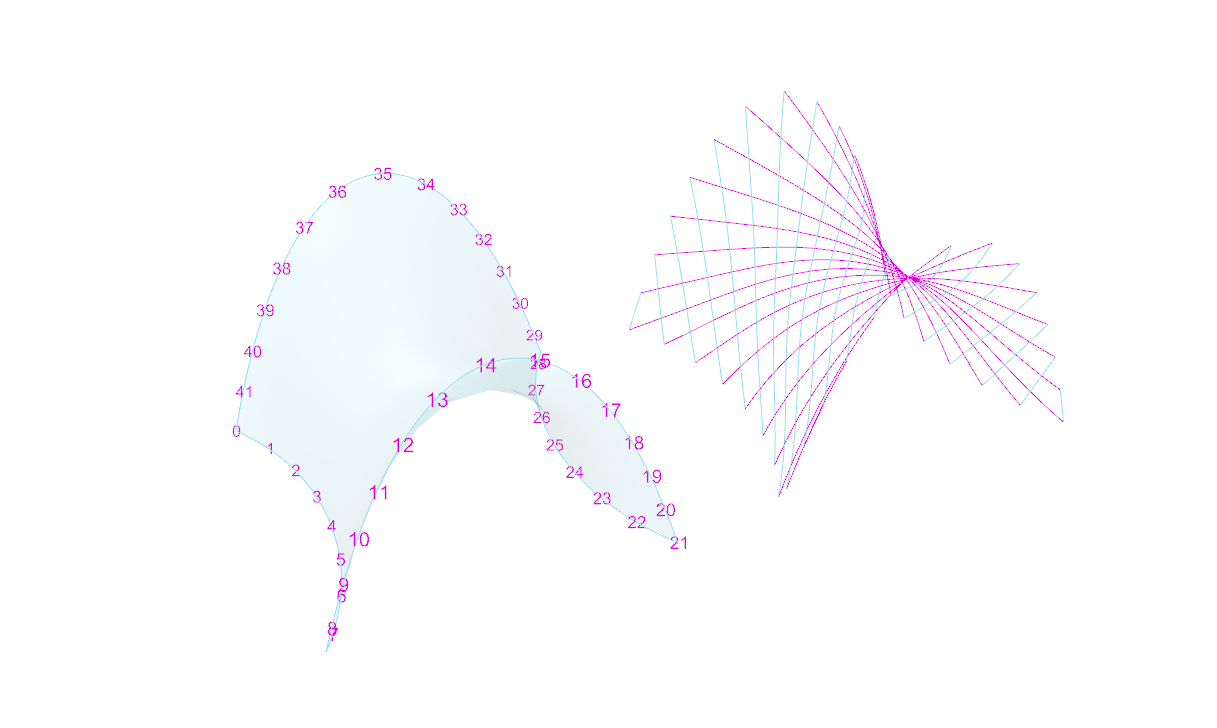
Structurally speaking, things get much more interesting with anticlastic curvature. As previously stated, each member will behave differently based on their relative curvature and orientation in relation to the surface. Depending on their location on a gridshell, plank lines can act partly in compression and partly in tension.
On another note:
While geodesic curves make it far more practical to fabricate shells, they are not a strict requirement. Using non-geodesic curves just means more time, money, and effort must go into the fabrication of each component. Furthermore, there’s no reason why you can’t use alternate grid patterns. In fact, you could use any pattern under the sun – any motif your heart desires (even tessellated puppies.)
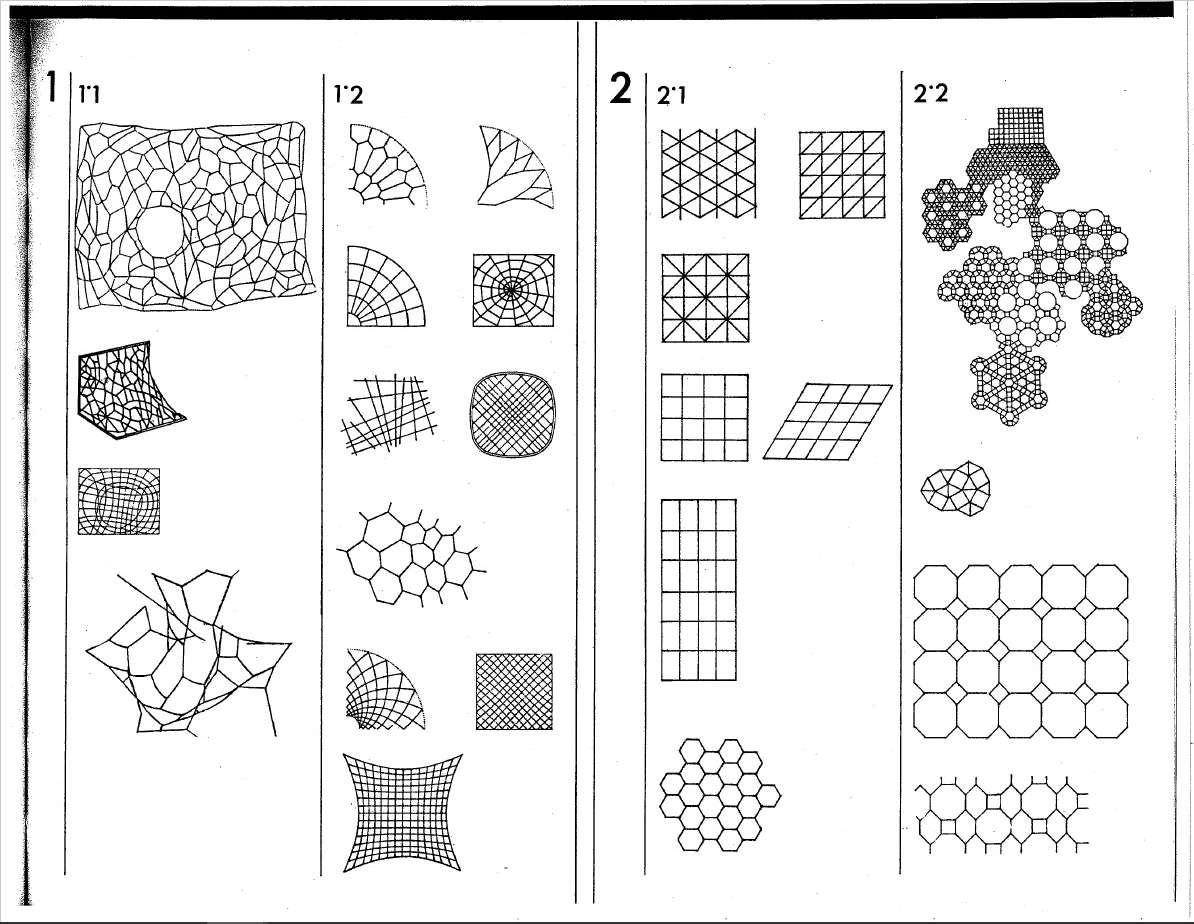
Here are just a few of the endless possible pattern. They all have their advantages and disadvantages in terms of fabrication, as well as structural potential.
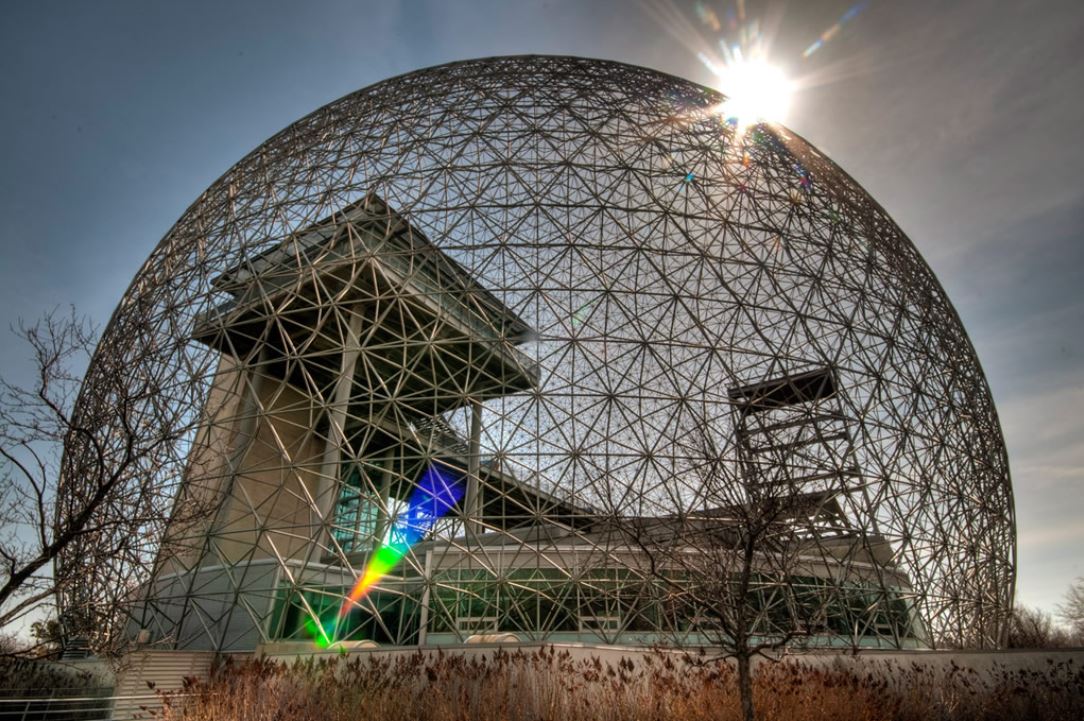
Gridshells with large amounts of triangulation, such as Buckminster Fuller’s geodesic spheres, typically perform incredibly well structurally. These structure are also highly efficient to manufacture, as their geometry is extremely repetitive.
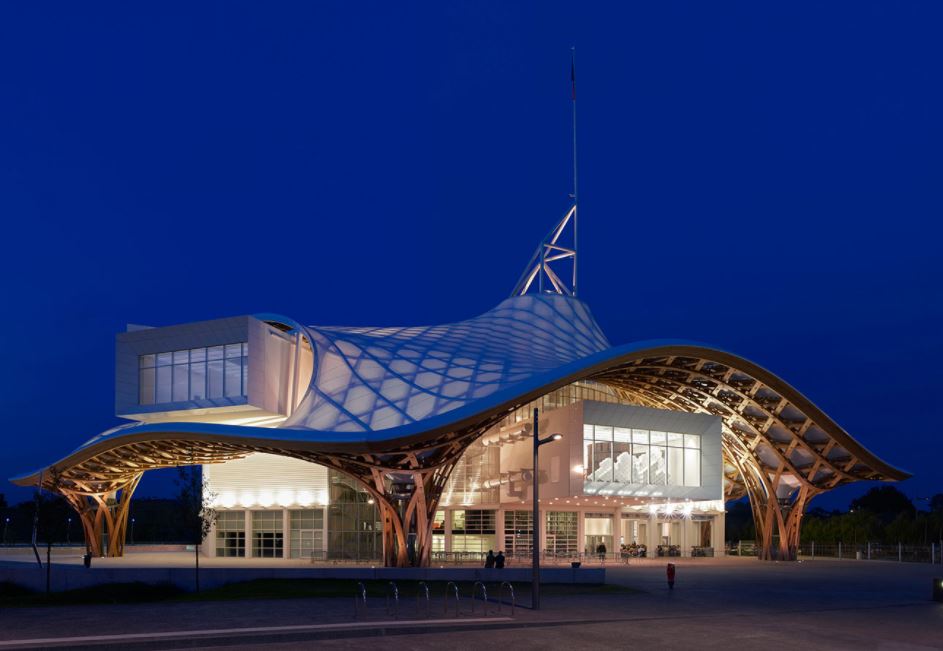
Gridshells with highly irregular geometry are far more challenging to fabricate. In this case, each and every piece had to be custom made to shape; I imagine it must have costed a lot of money, and been a logistical nightmare. Although it is an exceptionally stunning piece of architecture (and a magnificent feat of engineering.)
8.3 – Gridshell Construction
In our case, building these shells is simply a matter of converting the geodesic curves into planks lines.
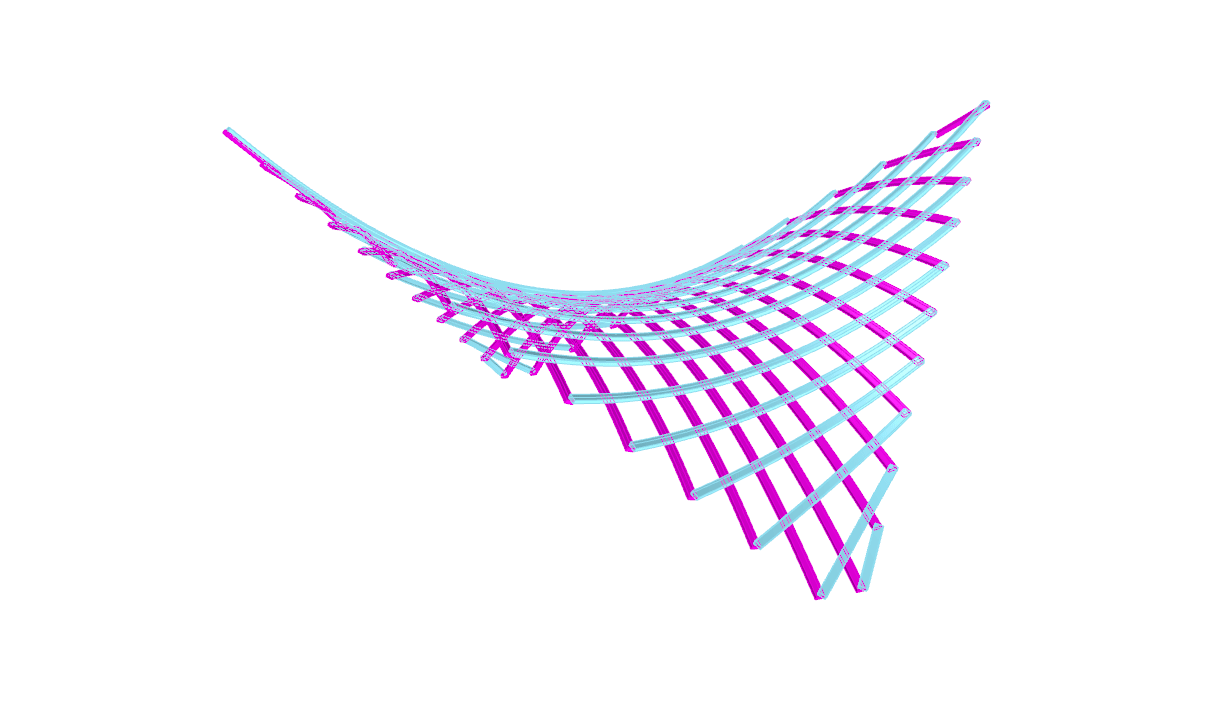
The whole point of using them in the first place is so that we can make them out of straight material that don’t necessitate double curvature. This example is rotating so the shape is easier to understand. It’s grid is also rotating to demonstrate the ease at which you can play with the geometry.
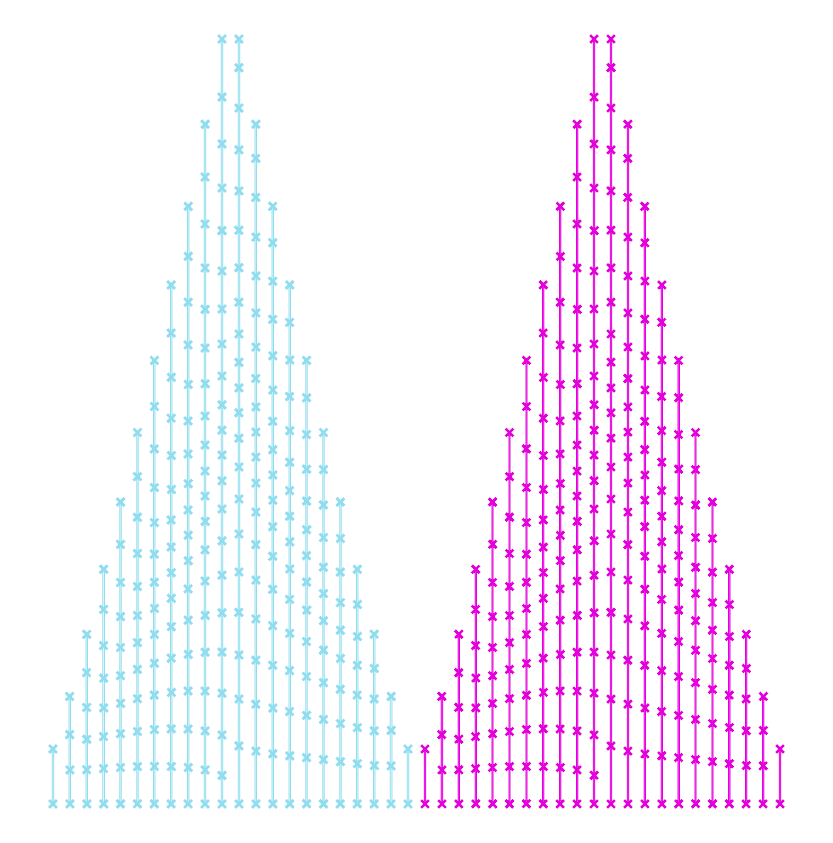
This is what you get by taking those plank lines and laying them flat. In this case both sets are the same because the shell happens to the identicall when flipped. Being able to use straight material means far less labour and waste, which translates to faster, and or cheaper, fabrication.
An especially crucial aspect of gridshells is the bracing. Without support in the form of tension ties, cable ties, ring beams, anchors etc., many of these shells can lay flat. This in and of itself is pretty interesting and does lends itself to unique construction challenges and opportunities. This isn’t always the case though, since sometimes it’s the geometry of the joints holding the shape together (like the geodesic spheres.) Sometimes the member are pre-bent (like Pompidou-Metz.) Although pre-bending the timber kinda strikes me as cheating thought.. As if it’s not a genuine, bona fide gridshell.
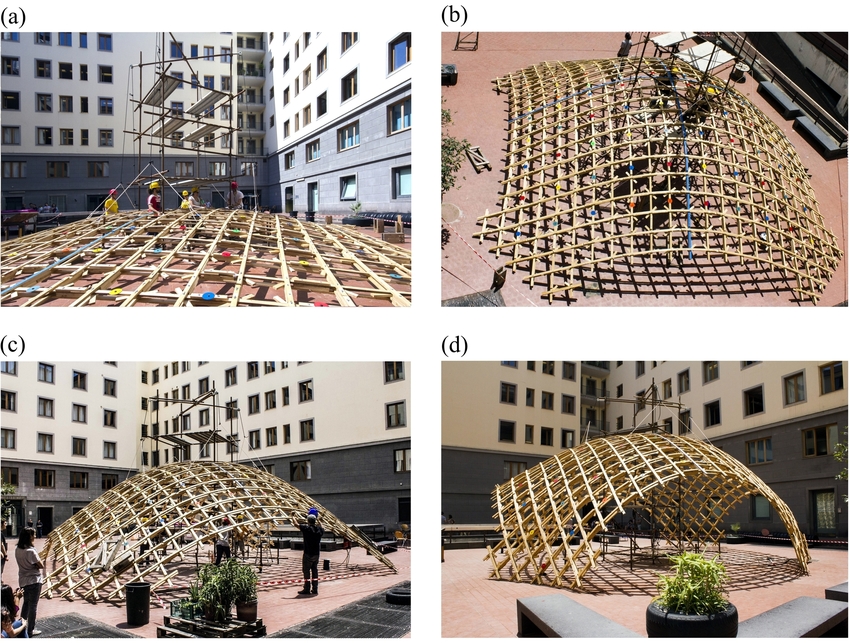
This is one of the original build method, where the gridshell is assembled flat, lifted into shape, then locked into place.
9.0 Form Finding
Having studied the basics makes exploring increasingly elaborate geometry more intuitive. In principal, most of the shells we’ve looked are known to perform well structurally, but there are strategies we can use to focus specifically on performance optimization.
9.0 – Minimal Surfaces
These are surfaces that are locally area-minimizing – surfaces that have the smallest possible area for a defined boundary. They necessarily have zero mean curvature, i.e. the sum of the principal curvatures at each point is zero. Soap bubbles are a great example of this phenomenon.
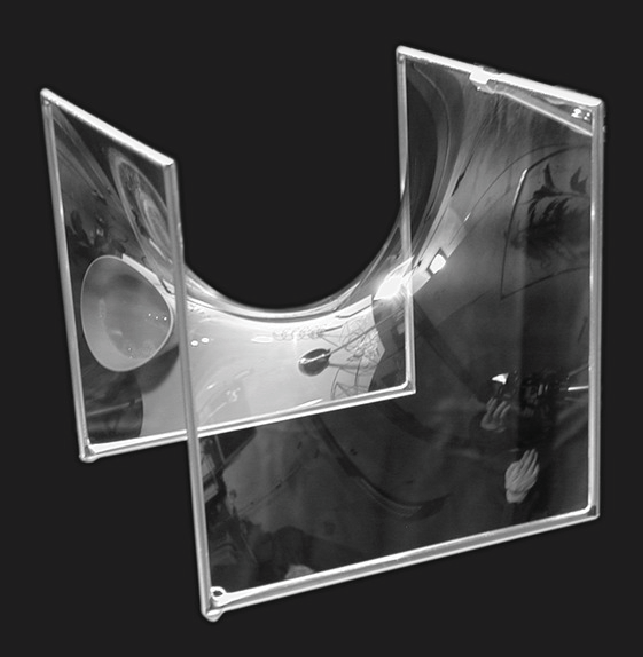
Hyperbolic Paraboloid Soap Bubble [Source: Serfio Musmeci’s “Froms With No Name” and “Anti-Polyhedrons”]Soap film inherently forms shapes with the least amount of area needed to occupy space – that minimize the amount of material needed to create an enclosure. Surface tension has physical properties that naturally relax the surface’s curvature.
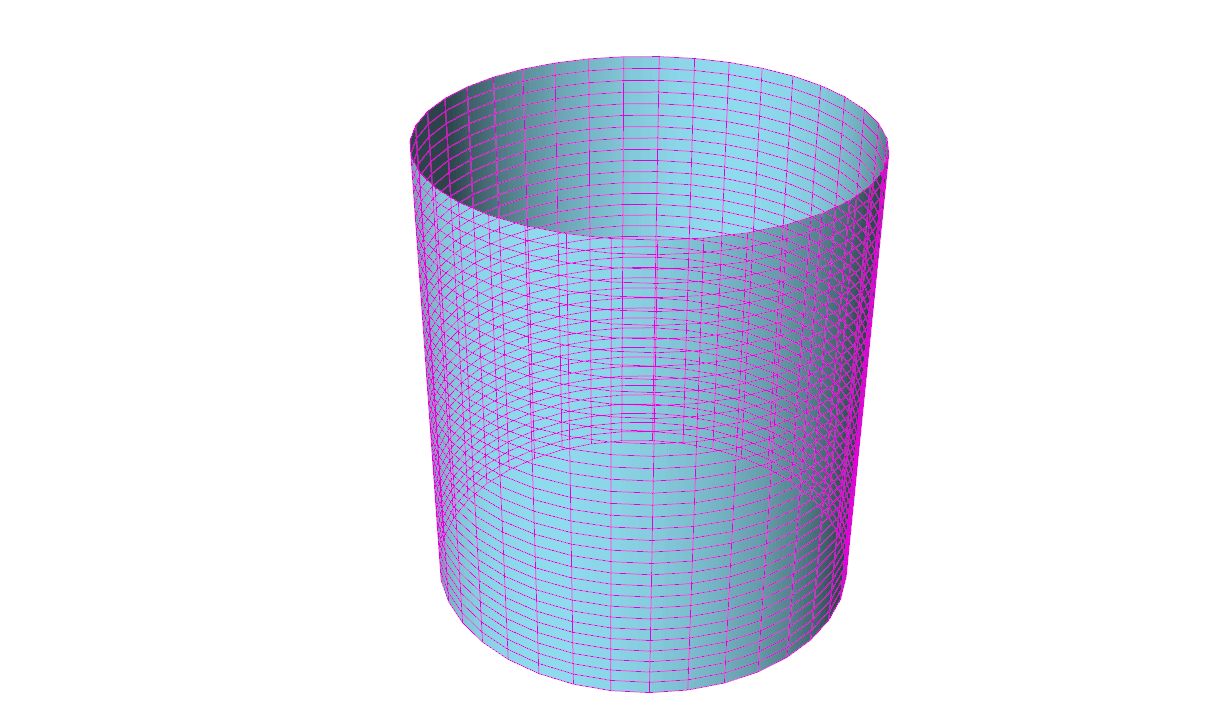
We can simulate surface tension by using a network of curves derived from a given shape. Applying varies material properties to the mesh results in a shape that can behaves like stretchy fabric or soap. Reducing the rest length of each of these curves (while keeping the edges anchored) makes them pull on all of their neighbours, resulting in a locally minimal surface.
Here are a few more examples of minimal surfaces you can generate using different frames (although I’d like stress that the possibilities are extremely infinite.) The first and last iterations may or may not count, depending on which of the many definitions of minimal surfaces you use, since they deal with pressure. You can read about it in much greater detail here: https://tinyurl.com/ya4jfqb2

Here we have one of the most popular examples of minimal surface geometry in architecture. The shapes of these domes were derived from a series of studies using clustered soap bubbles. The result is a series of enormous shells built with an impressively small amount of material.
Triply periodic minimal surfaces are also a pretty cool thing (surfaces that have a crystalline structure – that tessellate in three dimensions):
9.2 – Catenary Structures
Another powerful method of form finding has been to let gravity dictate the shapes of structures. In physics and geometry, catenary (derived from the Latin word for chain) curves are found by letting a chain, rope or cable, that has been anchored at both end, hang under its own weight. They look similar to parabolic curves, but perform differently.
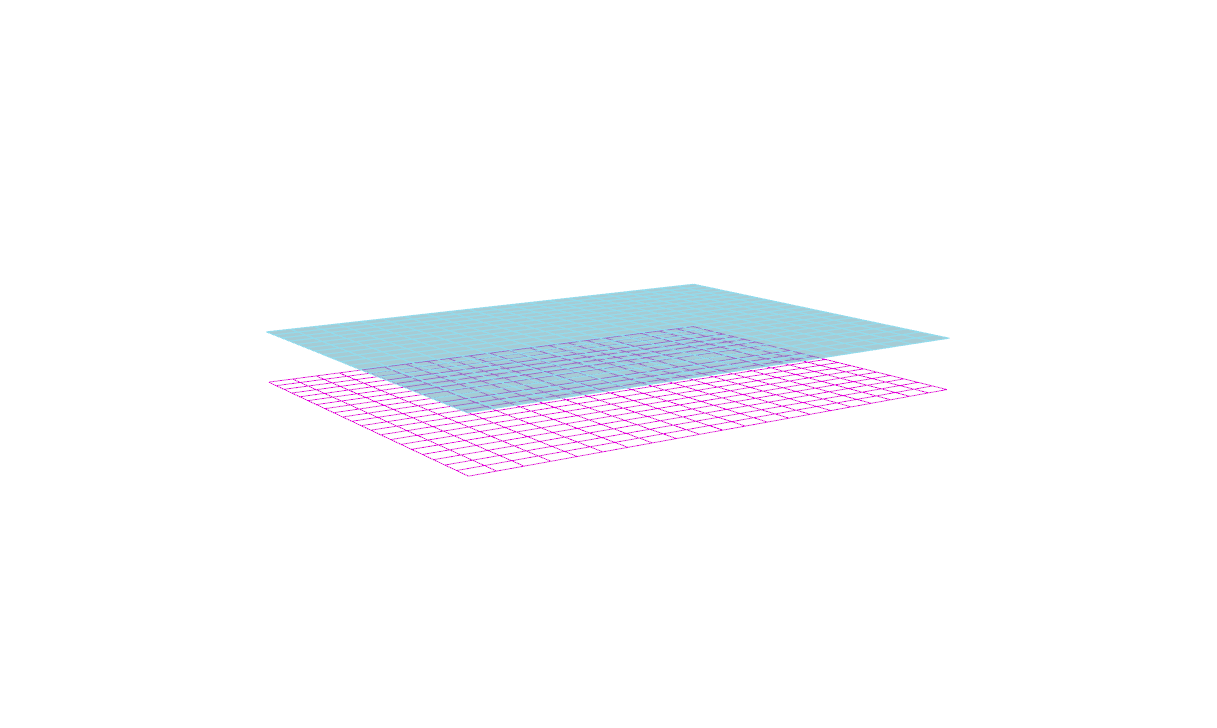
A net shown here in magenta has been anchored by the corners, then draped under simulated gravity. This creates a network of hanging curves that, when converted into a surface, and mirrored, ultimately forms a catenary shell. This geometry can be used to generate a gridshell that performs exceptionally well under compression, as long as the edges are reinforced and the corners are braced.
While I would be remiss to not mention Antoni Gaudí on the subject of catenary structure, his work doesn’t particularly fall under the category of gridshells. Instead I will proceed to gawk over some of the stunning work by Frei Otto.
Of course his work explored a great deal more than just catenary structures, but he is revered for his beautiful work on gridshells. He, along with the Institute for Lightweight Structures, have truly been pioneers on the front of theoretical structural engineering.
9.3 – Biomimicry in Architecture
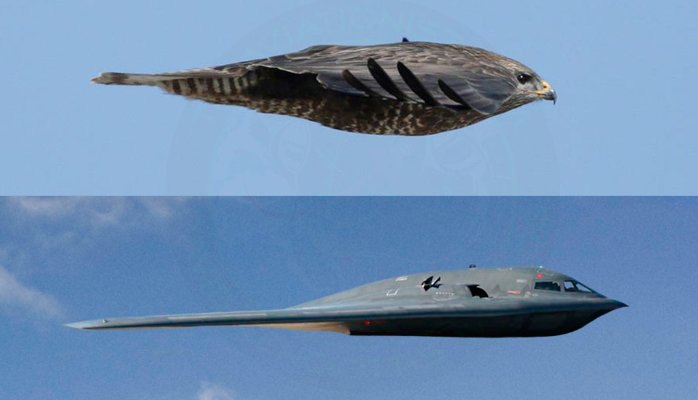
Frei Otto is a fine example of ecological literacy at its finest. A profound curiosity of the natural world greatly informed his understanding of structural technology. This was all nourished by countless inquisitive and playful investigations into the realm of physics and biology. He even wrote a series of books on the way that the morphology of bird skulls and spiderwebs could be applied to architecture called Biology and Building. His ‘IL‘ series also highlights a deep admiration of the natural world.
Of course he’s the not the only architect renown their fascination of the universe and its secrets; Buckminster Fuller and Antoni Gaudí were also strong proponents of biomimicry, although they probably didn’t use the term (nor is the term important.)
Gaudí’s studies of nature translated into his use of ruled geometrical forms such as hyperbolic paraboloids, hyperboloids, helicoids etc. He suggested that there is no better structure than the trunk of a tree, or a human skeleton. Forms in biology tend to be both exceedingly practical and exceptionally beautiful, and Gaudí spent much of his life discovering how to adapt the language of nature to the structural forms of architecture.
Fractals were also an undisputed recurring theme in his work. This is especially apparent in his most renown piece of work, the Sagrada Familia. The varying complexity of geometry, as well as the particular richness of detail, at different scales is a property uniquely shared with fractal nature.
Antoni Gaudí and his legacy are unquestionably one of a kind, but I don’t think this is a coincidence. I believe the reality is that it is exceptionally difficult to peruse biomimicry, and especially fractal geometry, in a meaningful way in relation to architecture. For this reason there is an abundance of superficial appropriation of organic, and mathematical, structures without a fundamental understanding of their function. At its very worst, an architect’s approach comes down to: ‘I’ll say I got the structure from an animal. Everyone will buy one because of the romance of it.”
That being said, modern day engineers and architects continue to push this envelope, granted with varying levels of success. Although I believe that there is a certain level of inevitability when it comes to how architecture is influenced by natural forms. It has been said that, the more efficient structures and systems become, the more they resemble ones found in nature.
Euclid, the father of geometry, believed that nature itself was the physical manifestation of mathematical law. While this may seems like quite a striking statement, what is significant about it is the relationship between mathematics and the natural world. I like to think that this statement speaks less about the nature of the world and more about the nature of mathematics – that math is our way of expressing how the universe operates, or at least our attempt to do so. After all, Carl Sagan famously suggested that, in the event of extra terrestrial contact, we might use various universal principles and facts of mathematics and science to communicate.
Developing Space-Filling Fractals
Delving deeper into the world of mathematics, fractals, geometry, and space-filling curves.
Foreword
4.0 Classic Space-Filling
4.1 Early Examples
In 1890, Giuseppe Peano discovered the first of what would be called space-filing curves:


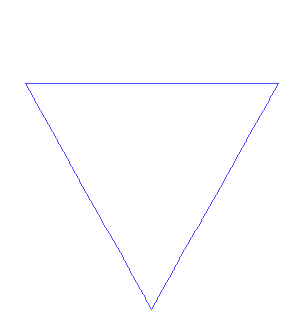

4.2 Later Examples
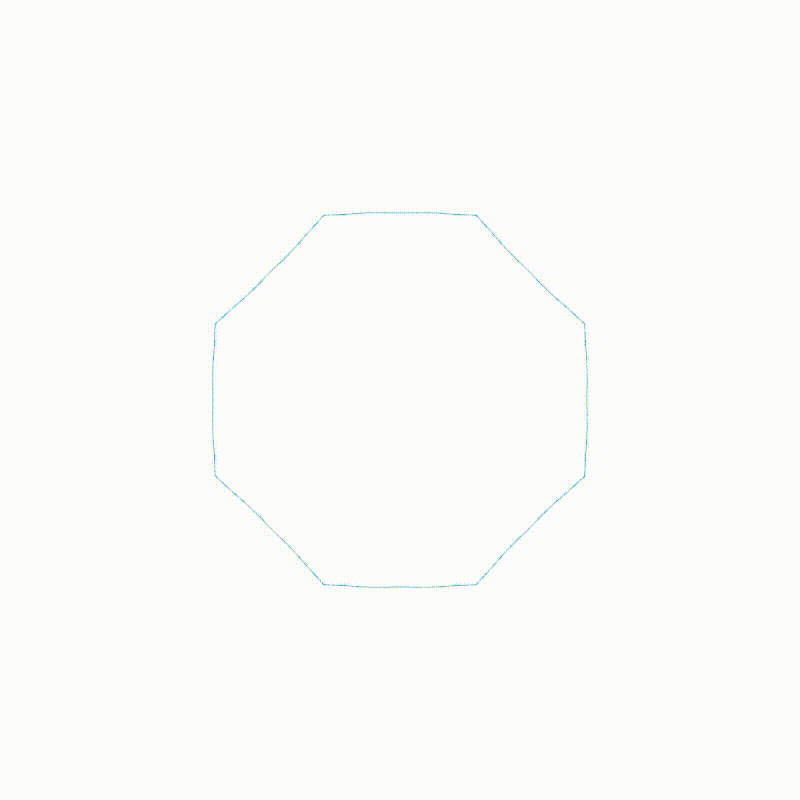
On A Strange Note:

5.0 Avant-Garde Space-Filling
5.1 The Traveling Salesman Problem
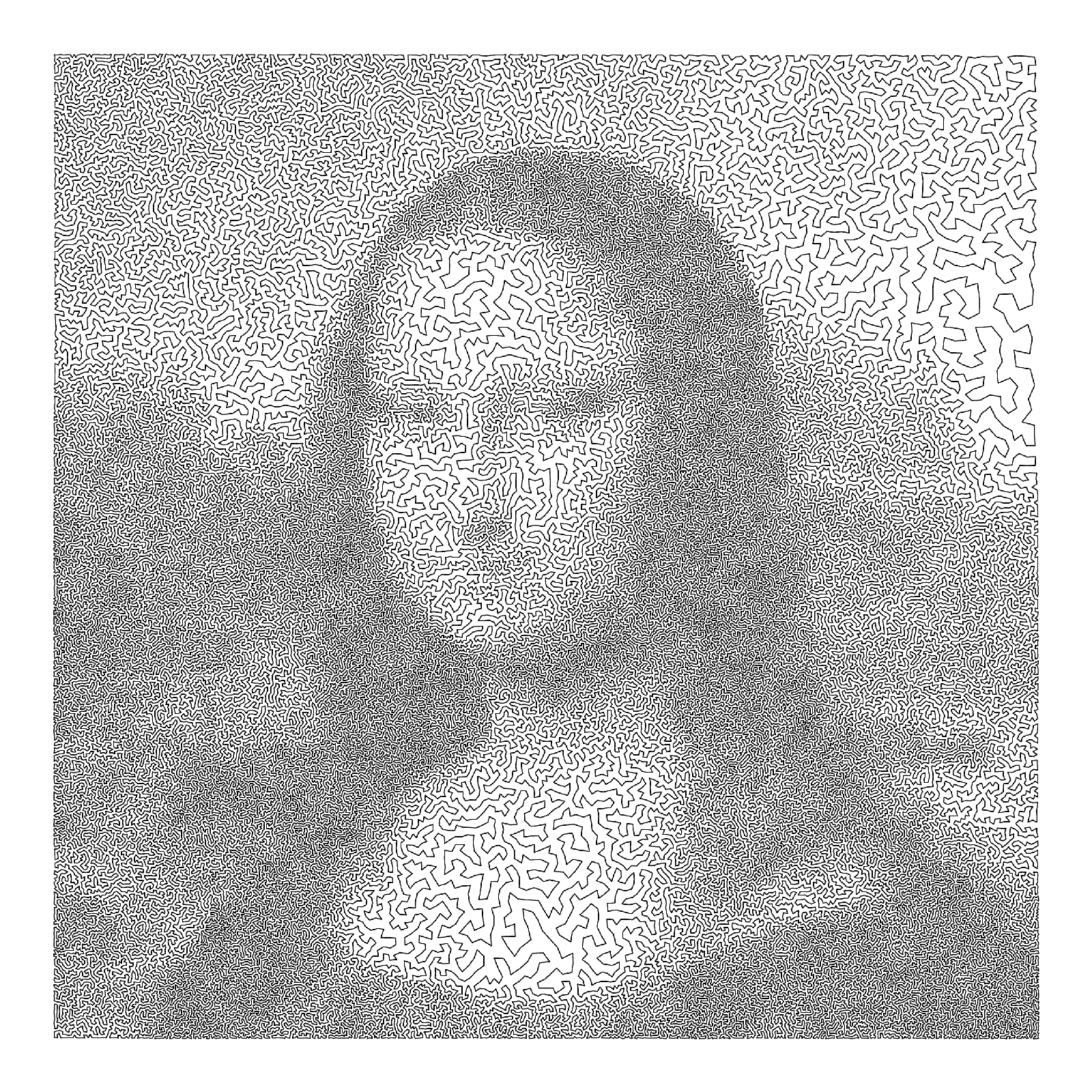
5.2 Differential Growth
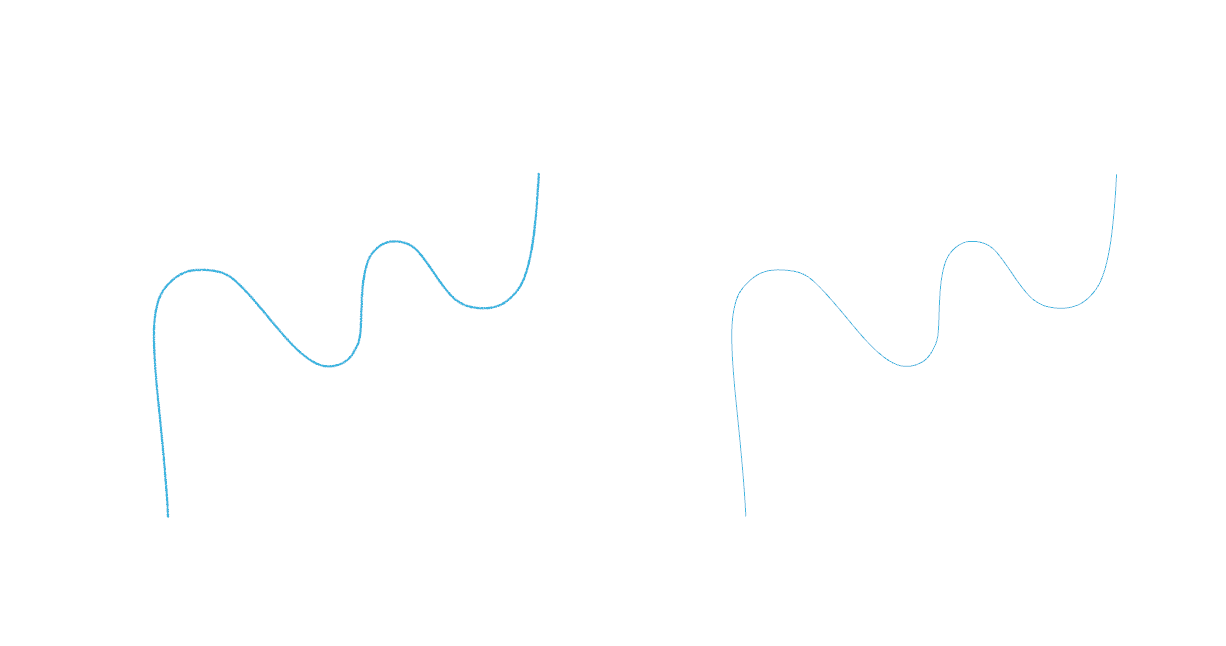
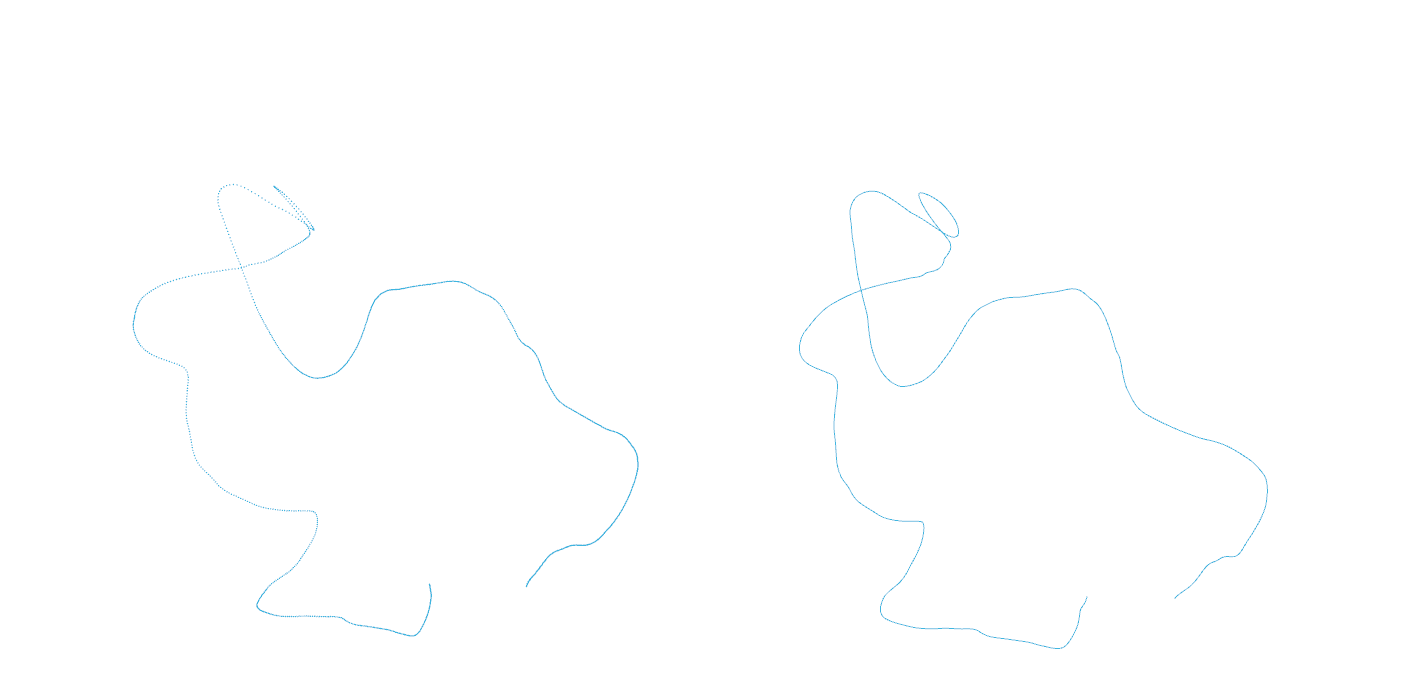
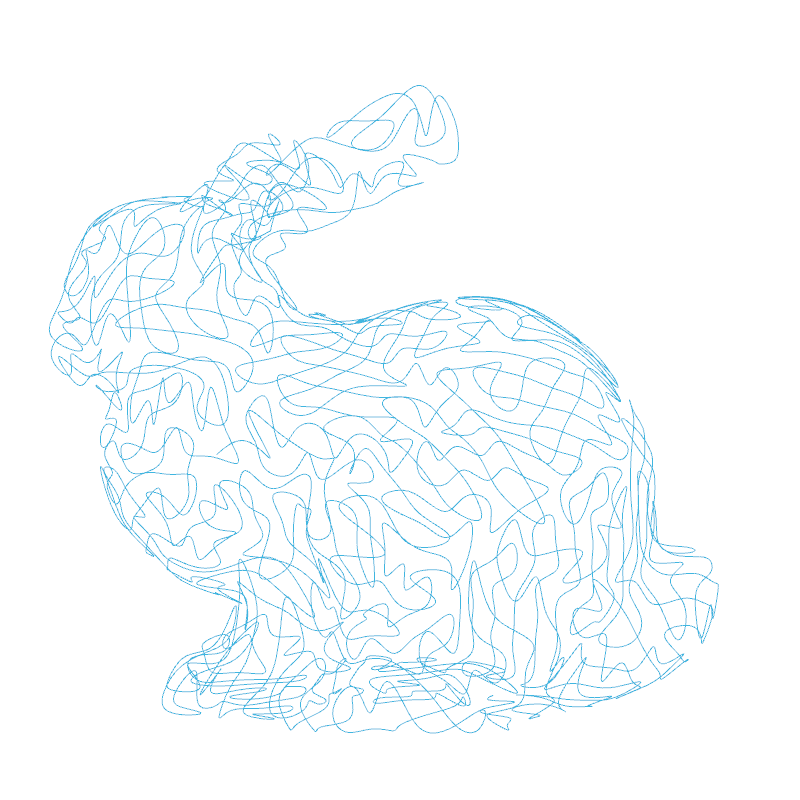


6.0 Developing Fractal Curves
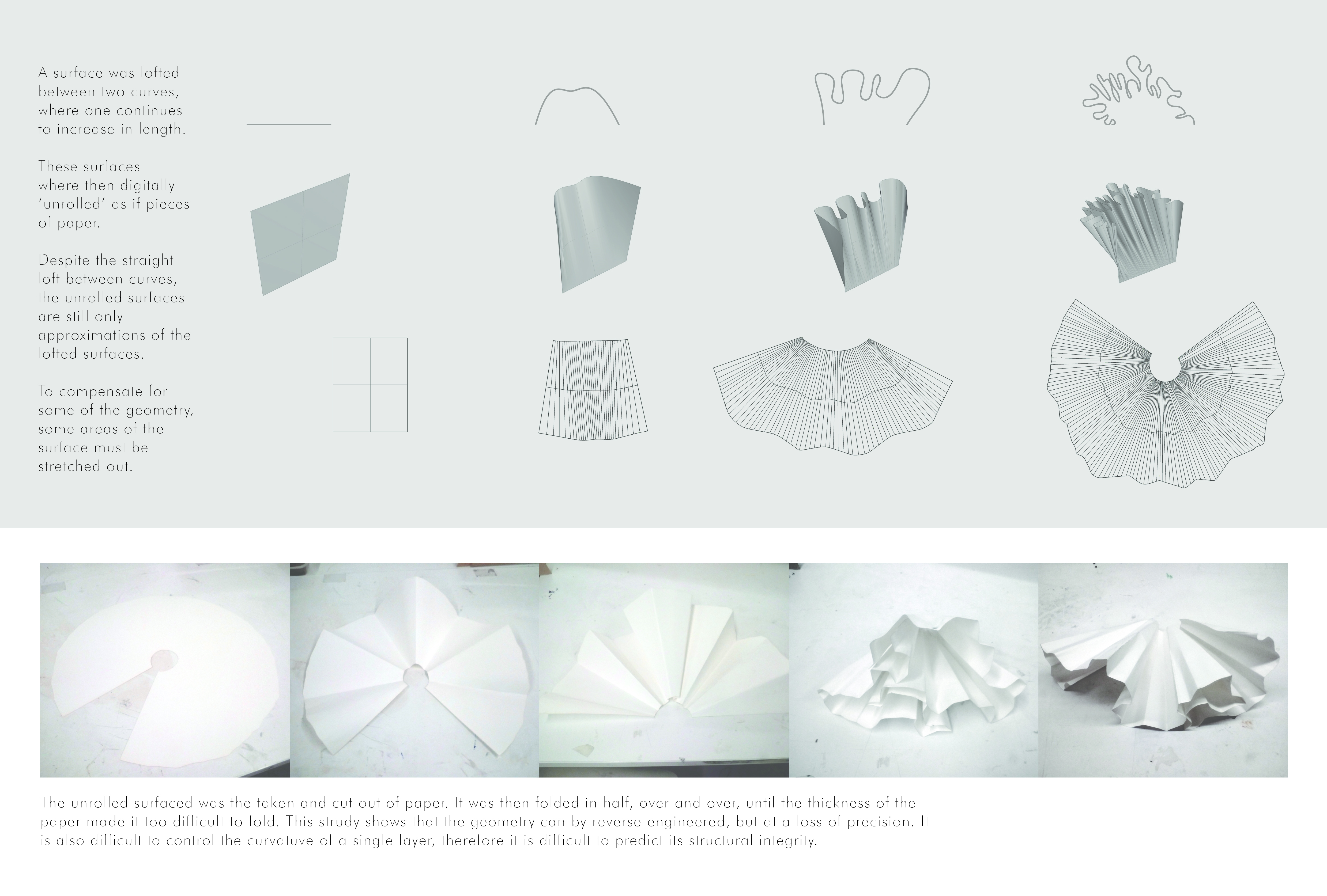
6.1 Dragon’s Feet
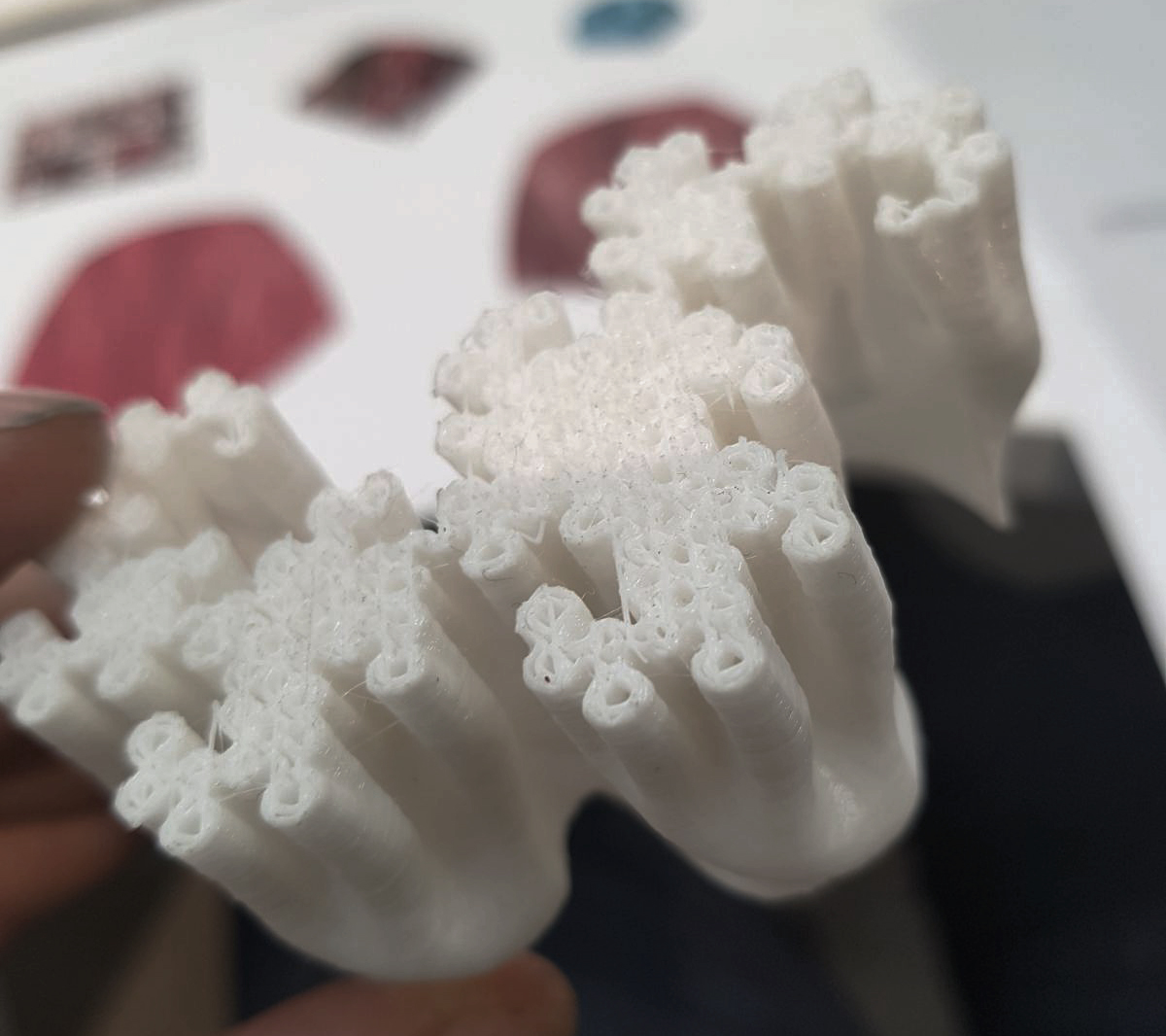
6.2 Hilbert’s Curtain
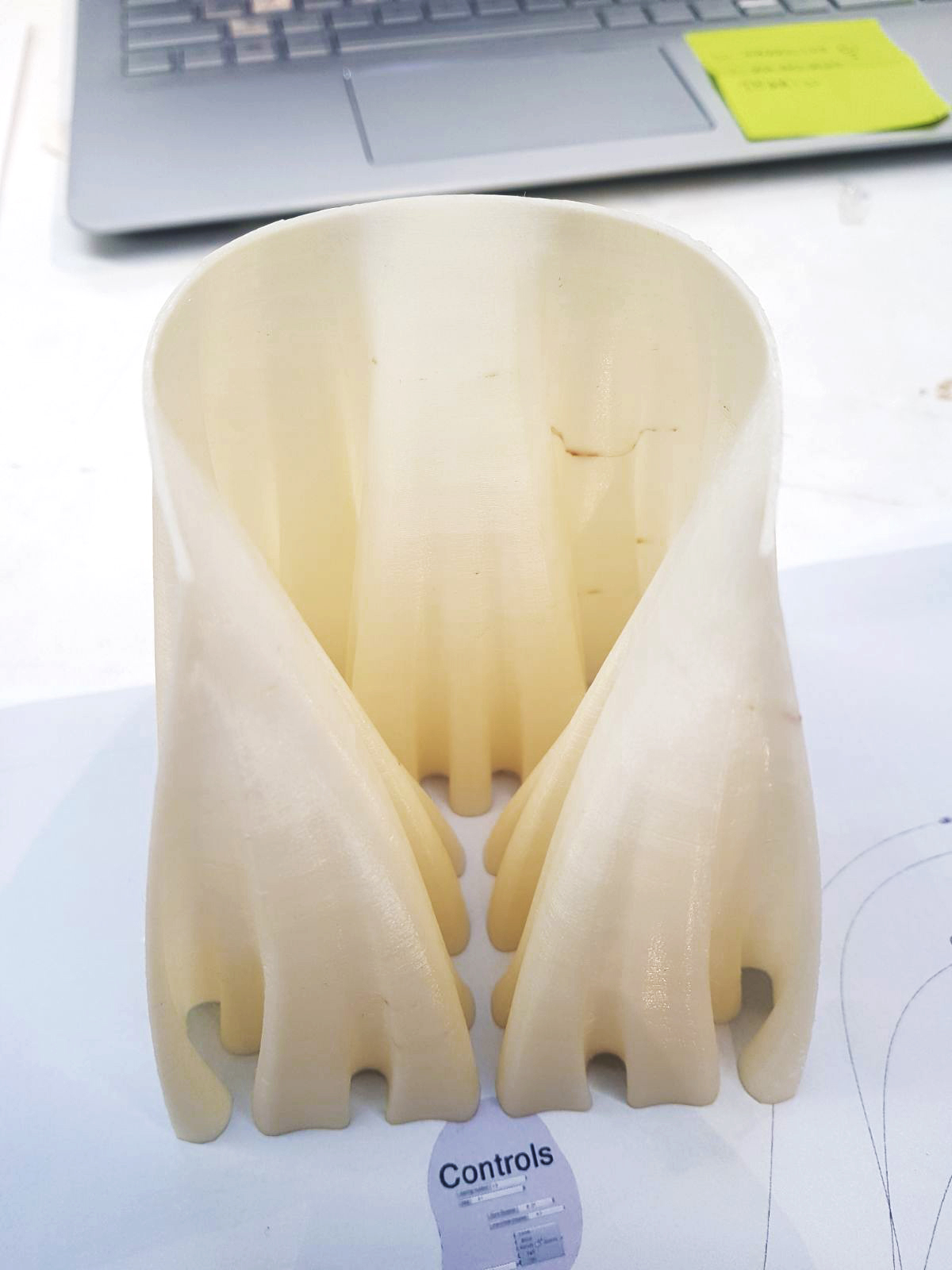
6.3 Developing Whale Curve
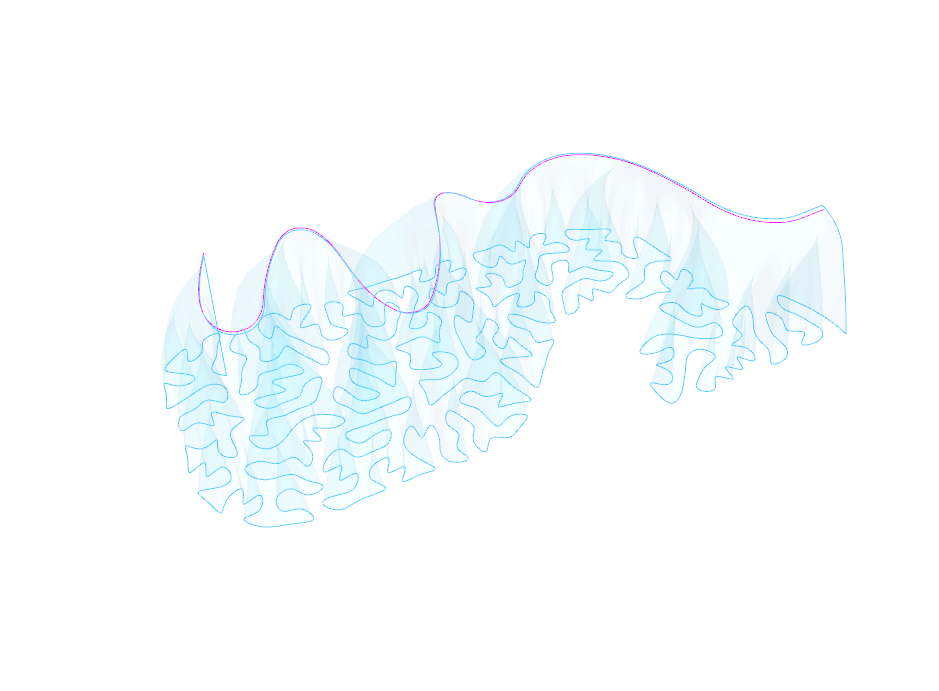
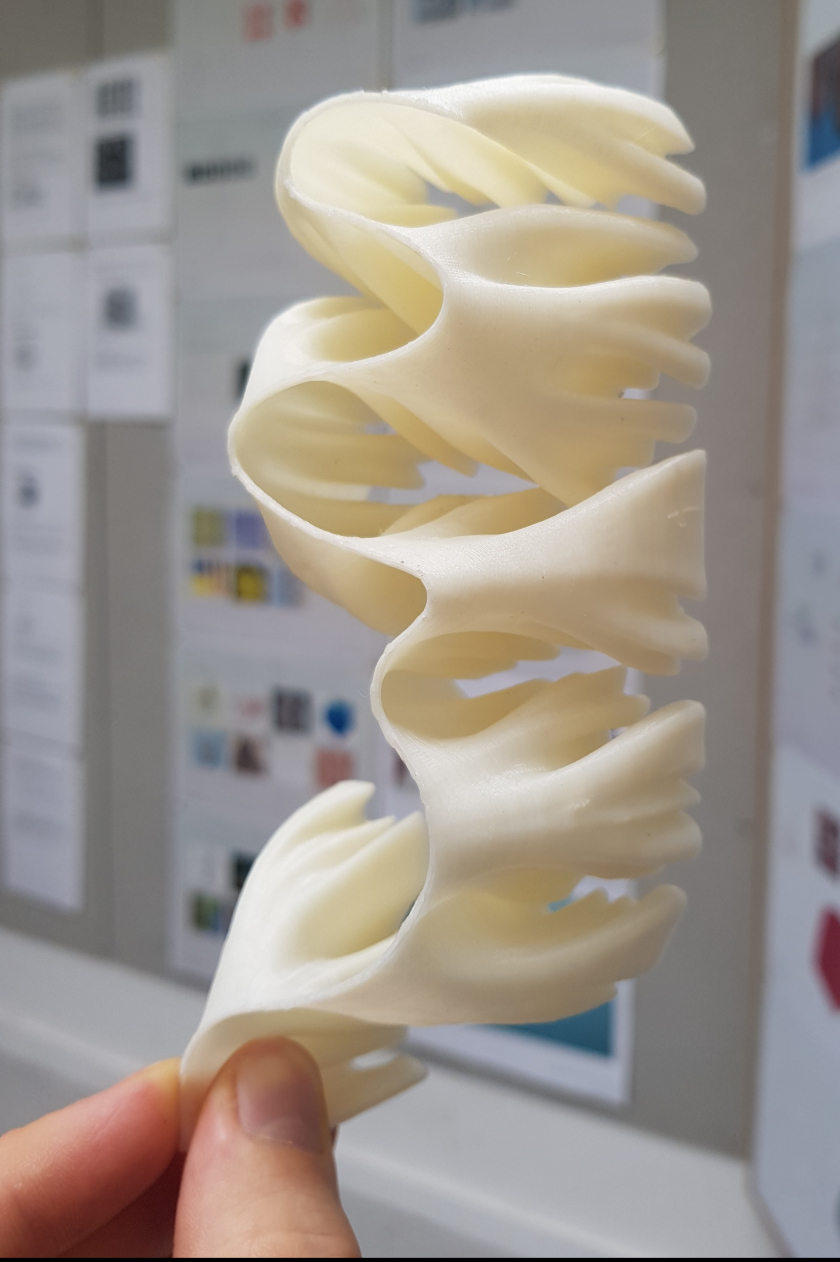
The Curves of Life
“An organism is so complex a thing, and growth so complex a phenomenon, that for growth to be so uniform and constant in all the parts as to keep the whole shape unchanged would indeed be an unlikely and an unusual circumstance. Rates vary, proportions change, and the whole configuration alters accordingly.” – D’Arcy Wentworth Thompson
“This is the classic reference on how the golden ratio applies to spirals and helices in nature.” – Martin Gardner

What makes this book particularly enjoyable to flip through is an abundance of beautiful hand drawings and diagrams. Sir Theodore Andrea Cook explores, in great detail, the nature of spirals in the structure of plants, animals, physiology, the periodic table, galaxies etc. – from tusks, to rare seashells, to exquisite architecture.
He writes, “a staircase whose form and construction so vividly recalled a natural growth would, it appeared to me, be more probably the work of a man to whom biology and architecture were equally familiar than that of a builder of less wide attainments. It would, in fact, be likely that the design had come from some great artist and architect who had studied Nature for the sake of his art, and had deeply investigated the secrets of the one in order to employ them as the principles of the other.”
Cook especially believes in a hands-on approach, as oppose to mathematic nation or scientific nomenclature – seeing and drawing curves is far more revealing than formulas.

 “because I believe very strongly that if a man can make a thing and see what he has made, he will understand it much better than if he read a score of books about it or studied a hundred diagrams and formulae. And I have pursued this method here, in defiance of all modern mathematical technicalities, because my main object is not mathematics, but the growth of natural objects and the beauty (either in Nature or in art) which is inherent in vitality.”
“because I believe very strongly that if a man can make a thing and see what he has made, he will understand it much better than if he read a score of books about it or studied a hundred diagrams and formulae. And I have pursued this method here, in defiance of all modern mathematical technicalities, because my main object is not mathematics, but the growth of natural objects and the beauty (either in Nature or in art) which is inherent in vitality.”
Despite this, it is clear that Theodore Cook has a deep love of mathematics. He describes it at the beautifully precise instrument that allows humans to satisfy their need to catalog, label and define the innumerable facts of life. This ultimately leads him into profoundly fascinating investigations into the geometry of the natural world.
Relevant Material

“An organism is so complex a thing, and growth so complex a phenomenon, that for growth to be so uniform and constant in all the parts as to keep the whole shape unchanged would indeed be an unlikely and an unusual circumstance. Rates vary, proportions change, and the whole configuration alters accordingly.” – D’Arcy Wentworth Thompson
D’Arcy Wentworth Thompson wrote, on an extensive level, why living things and physical phenomena take the form that they do. By analysing mathematical and physical aspects of biological processes, he expresses correlations between biological forms and mechanical phenomena.
He puts emphasis on the roles of physical laws and mechanics as the fundamental determinants of form and structure of living organisms. D’Arcy describes how certain patterns of growth conform to the golden ratio, the Fibonacci sequence, as well as mathematics principles described by Vitruvius, Da Vinci, Dürer, Plato, Pythagoras, Archimedes, and more.
While his work does not reject natural selection, it holds ‘survival of the fittest’ as secondary to the origin of biological form. The shape of any structure is, to a large degree, imposed by what materials are used, and how. A simple analogy would be looking at it in terms of architects and engineers. They cannot create any shape building they want, they are confined by physical limits of the properties of the materials they use. The same is true to any living organism; the limits of what is possible are set by the laws of physics, and there can be no exception.
Further Reading:

“You could look at nature as being like a catalogue of products, and all of those have benefited from a 3.8 billion year research and development period. And given that level of investment, it makes sense to use it.” – Michael Pawlyn
Michael Pawlyn, one of the leading advocates of biomimicry, describes nature as being a kind of source-book that will help facilitate our transition from the industrial age to the ecological age of mankind. He distinguishes three major aspects of the built environment that benefit from studying biological organisms:
The first being the quantity on resources that use, the second being the type of energy we consume and the third being how effectively we are using the energy that we are consuming.
Exemplary use of materials could often be seen in plants, as they use a minimal amount of material to create relatively large structures with high surface to material ratios. As observed by Julian Vincent, a professor in Biomimetics, “materials are expensive and shape is cheap” as opposed to technology where the inverse is often true.
Plants, and other organisms, are well know to use double curves, ribs, folding, vaulting, inflation, as well as a plethora of other techniques to create forms that demonstrate incredible efficiency.
PNEU + PACK
All living organisms are composed of cells, and cells are fluid-filled spaces surrounded by an envelope of little material- cell membrane. Frei Otto described this kind of structure as pneus.
From first order, peripheral conditions or the packing configuration spatially give rise to specific shapes we see on the second and third order.
This applies to most biological instances. On a larger scale, the formation of beehives is a translated example of the different orders of ‘pneu’.
Interested to see the impact of lattice configuration on the forms, I moved on to digital physics simulation with Kangaroo 2 (based on a script by David Stasiuk). The key parameters involved for each lattice configuration are:
Inflation pressure in spheres
Collision force between the spheres
Collision force of spheres and bounding box
Surface tension of spheres
Weight.
Physical exploration is also done to understand pneumatic behaviors and their parameters.
This followed by 3D pneumatic space packing. Spheres in different lattice configuration is inflated, and then taken apart to examine the deformation within. This process can be thought of as the growing process of seeds or pips in fruits such as pomegranates and citrus under hydrostatic pressure within its skin; and dissections of these fruits.
As the spheres take the peripheral conditions, the middles ones which are surrounded by spheres transformed into Rhombic dodecahedron, Trapezoid Rhombic dodecahedron and diamond respectively in Hex Grid, FCC Grid, and Square Grid. The spheres at the boundary take the shape of the bounding box hence they are more fully inflated(there are more spaces in between spheres and bounding box for expansion).
Physical experimentation has been done on inflatables structures. The following shows some of the outcome on my own and during an Air workshop in conjunction with Playweek led by Will Mclean and Laylac Shahed.

To summarize, pneumatic structures are forms wholly or mainly stabalised by either
– Pressurised difference in gas. Eg. Air structure or aerated foam structures
– liquid/hydrostatic pressure. Eg. Plant cells
– Forces between materials in bulk. Eg. Beehive, Fruits seeds/pips
There is a distinct quality of unpredictability and playfulness that pneumatic structures could offer. The jiggly nature of inflatables, the unpredictability resulted from deformation by compression and its lightweightness are intriguing. I will call them as pneumatic behaviour. I will continually explore what pneumatic materials and assembly of them could offer spatially in Brief 02. Digital simulations proved to be helpful in expressing the dynamic behaviours of pneumatic structures too, which I intend to continue.
The Butterfly Egg
Geometry can be found on the smallest of scales, as is proven by the beautiful work of the butterfly in creating her eggs. The butterflies’ metamorphosis is a recognised story, but few know about the start of the journey. The egg from which the caterpillar emerges is in itself a magnificently beautiful object.
Geometry can be found on the smallest of scales, as is proven by the beautiful work of the butterfly in creating her eggs. The butterflies’ metamorphosis is a recognised story, but few know about the start of the journey. The egg from which the caterpillar emerges is in itself a magnificently beautiful object. The tiny eggs, barely visible to the naked eye, serve as home for the developing larva as well as their first meal.
![White Royal [Pratapa deva relata] HuDie's Microphotography](https://wewanttolearn.files.wordpress.com/2015/11/the-square-egg.jpg)

Each kind of butterfly has its unique egg design, creating a myriad of beautiful variations.
These are some of the typical shapes that each family produce.
But it is the Lycaenidae family that have the most geometrical and intricate eggs.


Biomimetics, or biomimicry is an exciting concept that suggests that every field and industry has something to learn from the natural world. The story of evolution is full of problems that have been innovatively solved.

There are thousands of species of butterfly, each with their unique egg design.  A truncated icosahedron for a frame, the opposite of a football. Instead of panels pushed out, they are pulled in.
A truncated icosahedron for a frame, the opposite of a football. Instead of panels pushed out, they are pulled in.




Fractals are commonly occurring in nature, and can be described as a never-ending pattern on different scales. People are subconsciously familiar with fractals, so are inherently more relaxed when surrounded by them.



















3D Printing is a relatively new technology that is set to change our world. Innovations in the uses of 3D printers, combined with falling costs, means that they could be a ubiquitous tool in every home and industry. 3D printers and scanners are already used a great deal in everything from the biomedical field to art studios, and experiments are currently being done to construct entire homes. This technology is in its infancy, and it is exactly for this reason that every effort should be taken to research its potential. It is common to use 3D printers in architecture to show small working models, I would like to now use it to make a large and complex structure at full scale.

This research will underpin the design of a sculptural installation in which people can interact with live butterflies. With the ever-declining numbers of butterflies worldwide and in the UK, conservation and education are paramount.
The link between butterflies and humans in our ecosystem is one that is vital and should be conserved and celebrated.
I can imagine an ethereal space filled with dappled light where people can come for contemplation and perhaps their own personal metamorphosis.

—Tia
Elastic Bending Systems
In physics, elasticity (from Greek ἐλαστός “ductible”) is the ability of a body to resist a distorting influence or stress and to return to its original size and shape when the stress is removed.
This can be explained looking closer at the components which form the cytoskeleton – the cellular structure – formed of elastic and semi-elastic arrangements of proteins, which are adaptable to the cell’s requirements. Not only do they hold the structural integrity of the cell, but they also also perform functions of communication, transport combined with other “plug-in” proteins, whilst elastically responding to external forces or stimuli.
Elastic bending is used in both natural as well as man-made environments, expanding surfaces and volumes of various deployable structures.
The force responsible for elastic bending can be described in terms of the amount of deformation (strain) resulting from a given stress, a ratio known as Young’s Modulus. Hooke’s Law adds that the force responsible with restoring the initial shape of a bent material is proportional to the amount of stretch.
Using the formulas given by Young’s Modulus and Hooke’s Law, we can determine how much a certain material will bend when a force is applied to it.
Deploying structures using bending is a space and construction time saving method of producing structural elements which mimic the behaviour of natural systems.
After the structure is deployed, equilibrium of forces is required in order to keep the structure open and usable.
This can either be achieved by combining bending elements with meshes,
or by using the acting forces of bending elements against the reacting forces of other bending elements in both 2D and 3D.
Using these principles of acting forces vs. reacting forces, an elastic module in equilibrium is created, which can be stacked using its geometry to achieve various configurations.
Furthermore, using the same principles, a larger module is created containing groups of elements producing forces acting and reacting against each other, in order to achieve equilibrium.
However, due to the elastic properties of the newly formed module, the structure can bend and morph shape without losing integrity or equilibrium, in order to form various shapes, or respond to or external factors or users requirements, similarly to the cytoskeleton initially studied.
- Mihai Chiriac
Timber Wave by Henry Turner
Philosophical Statement:
‘Timber-Wave’; a plywood instillation emerging and crashing on to the desolate Black Rock Desert. This breaking wave a remnant of the retreating Quinn River, draws on imagery of both waves and dunes provoking thoughts of the original Burning Man Beach Parties and surfing counter culture. Simultaneously the design evokes concepts of the Silk Road as a mirage of a giant wave appearing from across the playa to be discover by wondering burners.
The design of the Timber Wave was driven by creating an interactive environment. In daytime, people are encourages to climb and search between the interwoven plywood structure. Open sun soaked communal areas create areas for group contemplation. Solitary areas for single travelers have also been designed as places of refuge from the intense sun, wind and dust storms hoping to encourage serendipity. At night the wave truly come alive as a monument to the sea. Bathed in varying blue tones of color the spectacular structure is a mysterious beacon within the dark playa.
Physical Statement:
‘Timber-Wave’ structure consists of 3 layers of 12 intersecting plywood ribbons. Each ribbon consists of a varying number of water bent plywood components con-caving and con-vexing together forming a rigid series of tensioned and compressed sections. The result is a homogeneous structure creating a beautiful ergonomically sized spaces. Each ribbon a series of circular penetrations in the form of an abstracted water pattern. Creating foot and hand holes for climbing as well as allowing dramatic shadows to be cast throughout the structure and across the playa. At night the penetrations allow the lighting of the instillation to spill across the playa and between the layers of the structure.
1:20 Scale Model
Lotus Hypars
Lotus Hypars – A study of hyperbolic bamboo structures
The Lotus Hypars symbolise the “Caravansary” trading centre. The structure is assembled as the centre for exchange after journeying across land and water to a resting point, Burning Man. Hammocks offer a space for the festivals unique style of trading to be discussed and carried out. The tangible nature of the Lotus also creates a playfulness in an otherwise formal system of resources exchange. The lightweight structure evolves from the horizontal lines of the desert and forms a hyperbolic shelter. The user can inhabit not only underneath the structure, but also the petal shaped hammocks. Here, individuals can exchange stories, supplies and treasures.
In Buddhism, the Lotus flower is symbolic of fortune. It grows in muddy water, and it is this environment that gives forth the flower’s first and most literal meaning: rising and blooming above the murk to achieve enlightenment. The Lotus Hypar story has evolved from the same principles. In the harsh desert environment, man can create beauty. The folded geometries are playfully excited by human participation. A twist, a fold and a push.
The structure is assembled using bamboo sticks that are arranged in a reciprocal formation. These canes are then bound using high strength elastic bands. This allows for the flat cells to twist and take on new shapes. The Lotus Hypar is formed by a repetitive series of folds and the result forms petals. These are symbolic of the Lotus flower. The cells are covered with a white semi-elastic membrane that adds to the strength of the structure and the petal geometries become more visible. These are also the hammocks that can be inhabited by the Burning Man users.
In order to test the structural performance of the proposal, I constructed a series of 1:1 scale models. This was done using 6m and 3m bamboo canes (35mm diameter). By testing a small segment of the full proposal, it is easier to determine the success of the final proposal.

